Looking for an entrance that feels timeless yet on-trend? White oak’s tight grain, warm tone and proven weather resistance make it the wood designers now reach for when they want durability with natural character. From minimalist planks to carved showpieces, this species pairs effortlessly with every architectural style and is front-and-center in 2025 curb-appeal reports that celebrate larger, statement-making doors. The 20 ideas below break down finishes, hardware, and construction details so you can choose a white oak front door that greets guests with style and stands up to the elements for decades.
1. White Oak Front Door With Beveled Glass Panels
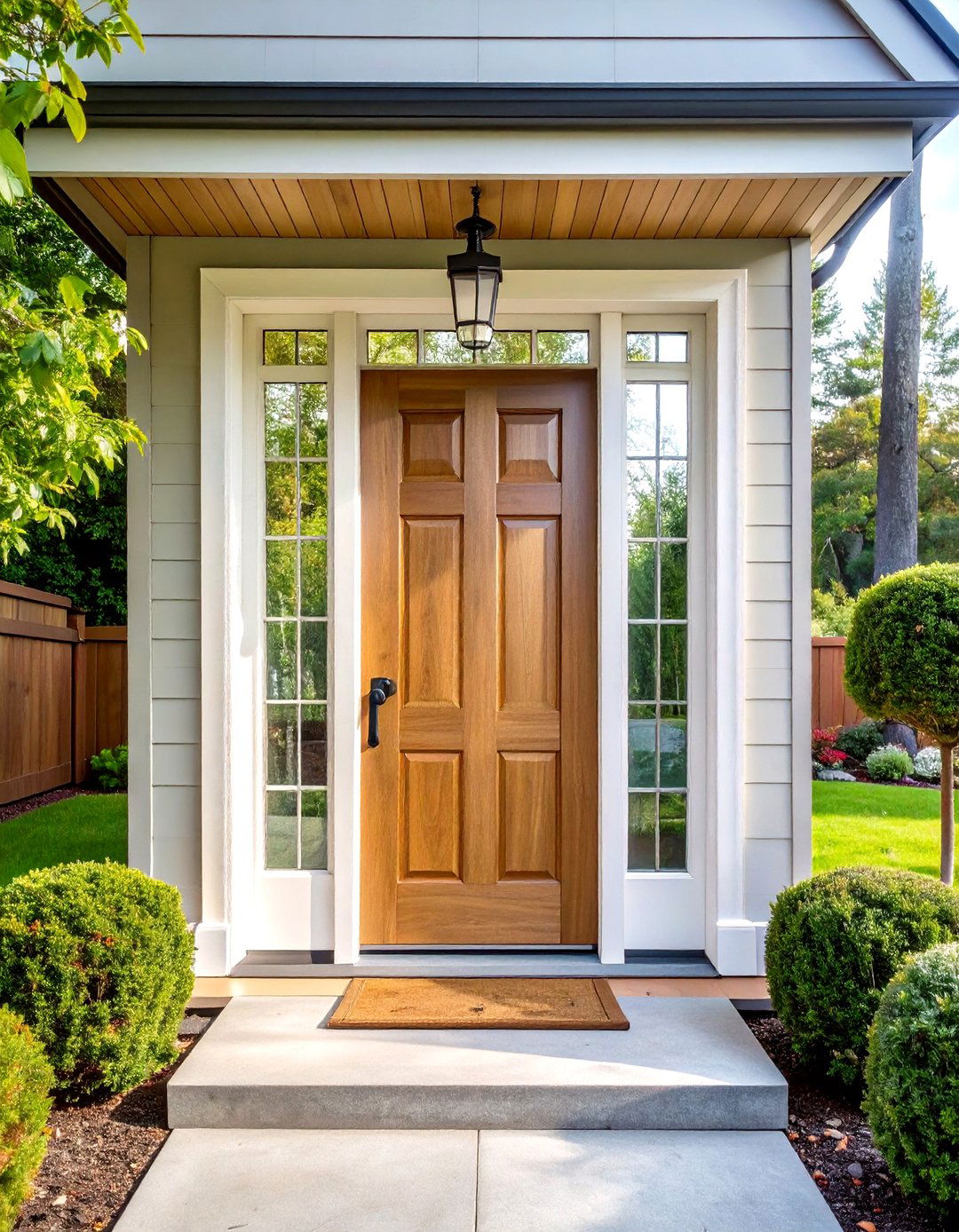
A beveled-glass insert instantly adds sparkle and classic charm while letting sunrise light flood your foyer. White oak’s subtle grain keeps the look refined, so the glass facets remain the star rather than competing with busy wood figure. Choose safety-rated double glazing to improve insulation and ask your joiner to set the panes proud of the rails for an elegant jewel-box effect. Decorative lead lines or zinc caming echo traditional craftsmanship without feeling fussy. Home-center catalogues show how the crisp bevel edges cast prismatic patterns across the entry tile. Finish the slab with a low-luster marine varnish so the oak color glows behind the glass.
2. White Oak Front Door With Vertical Plank Pattern
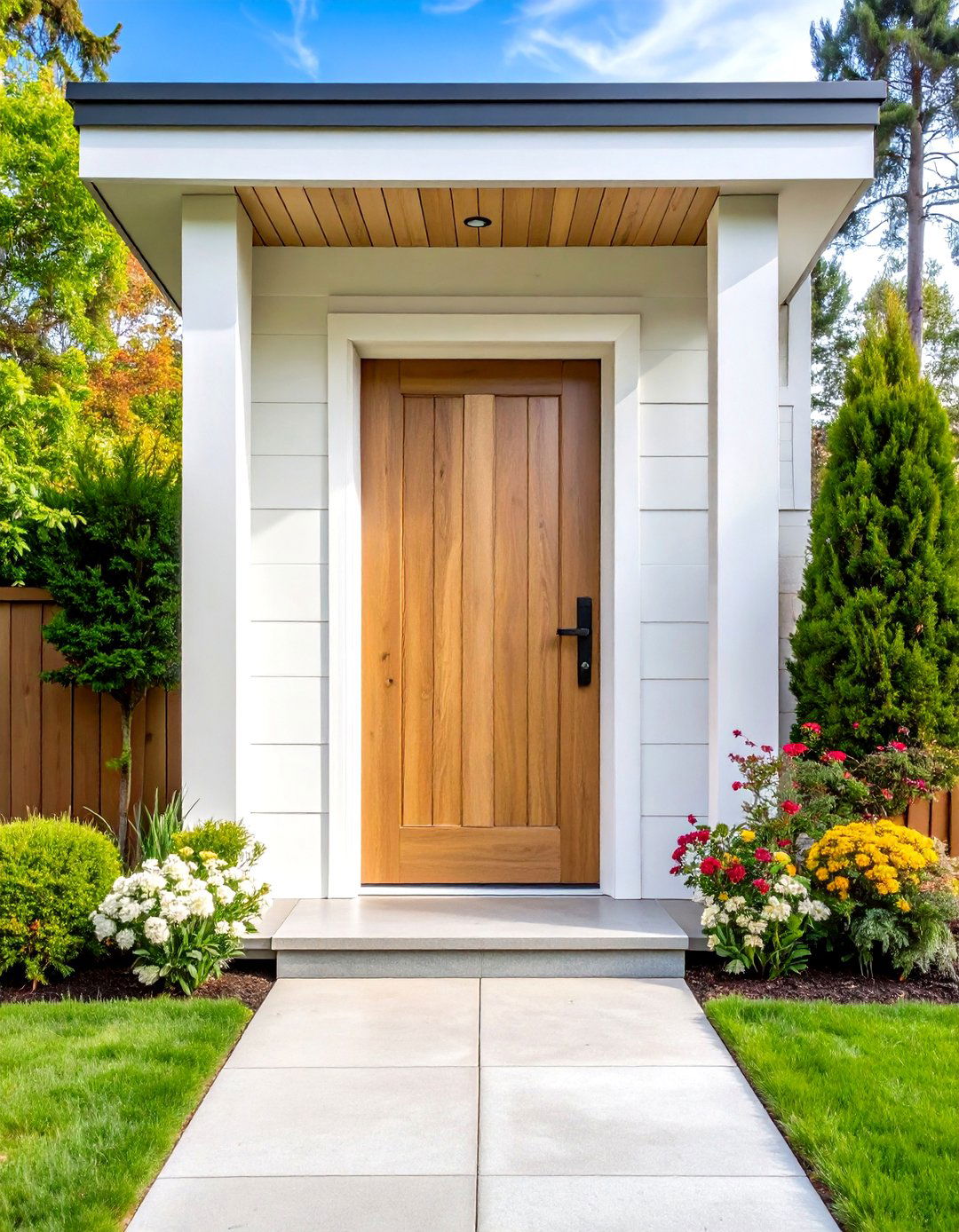
By running narrow vertical planks from threshold to lintel you draw the eye upward and make even a modest porch appear taller. White oak mills clean edges that butt tightly together, so a simple tongue-and-groove joint is all that’s needed to create a monolithic surface. Add a slim flush pull instead of a protruding handle to keep the silhouette uninterrupted. The subtle rhythm of the boards provides texture without sculpture, a look Scandinavian architects love for its quiet order. PlusMood showcases a similar design where barely visible V-grooves catch afternoon sun like pin-stripes. Seal the end grain with penetrating oil to resist moisture creep, ensuring those lines stay crisp for decades.
3. White Oak Front Door With Wide Modern Pivot
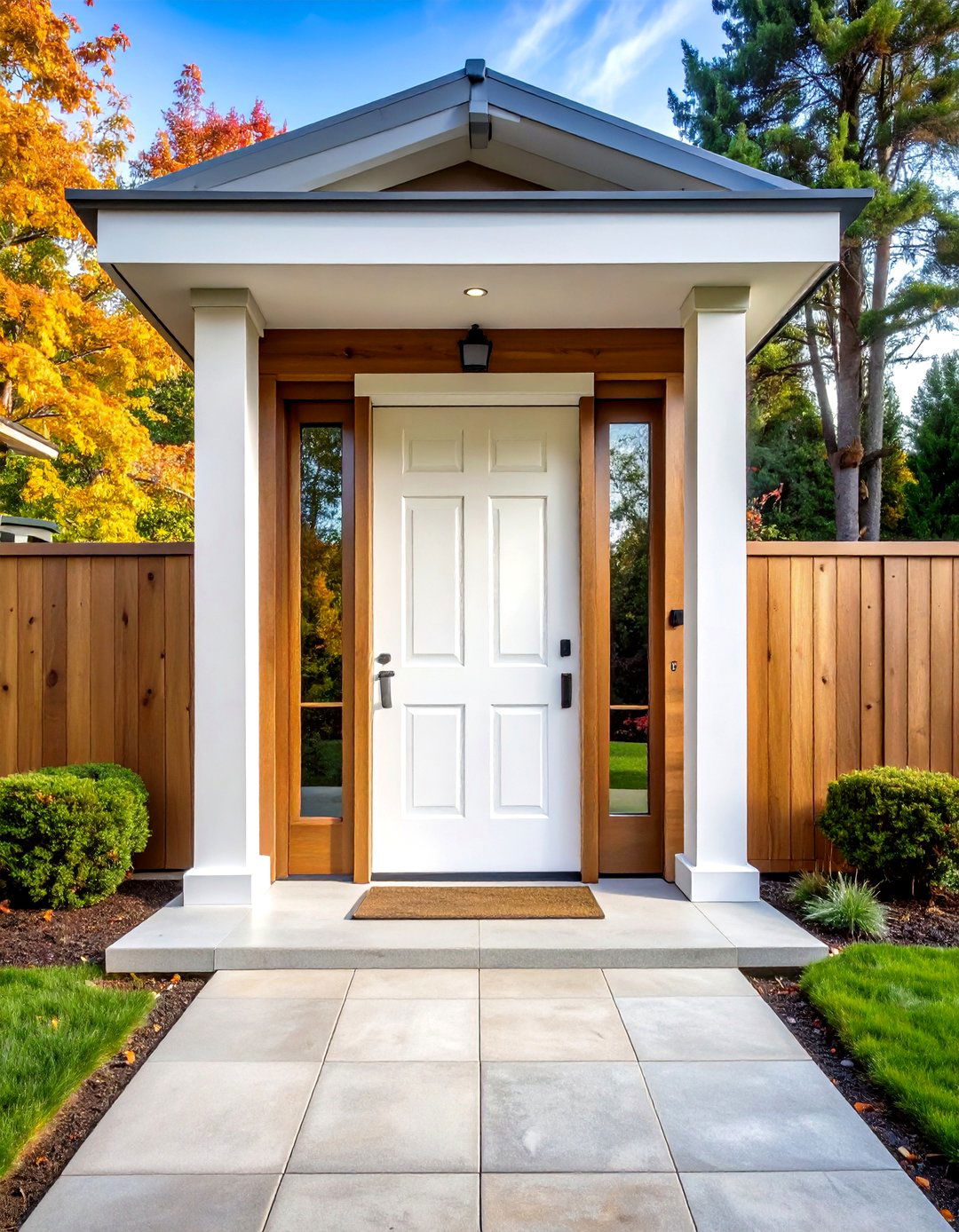
Unlike side-hinged leaves, a pivot door rotates on an offset spindle, allowing you to use a dramatically wider slab without stressing traditional hinges. White oak’s density keeps the large panel rigid, while the hidden floor-mounted pivot bears the weight and offers buttery movement that impresses guests before they even step inside. Specify concealed closers for controlled soft-close action and a perimeter drop seal to block drafts. Urban & Grey notes that pivot systems excel at supporting heavier hardwoods, delivering both stability and minimalist aesthetics. Pair the slab with floor-to-ceiling sidelights so the pivot seems to float within a glass frame.
4. White Oak Front Door Dutch Split Style
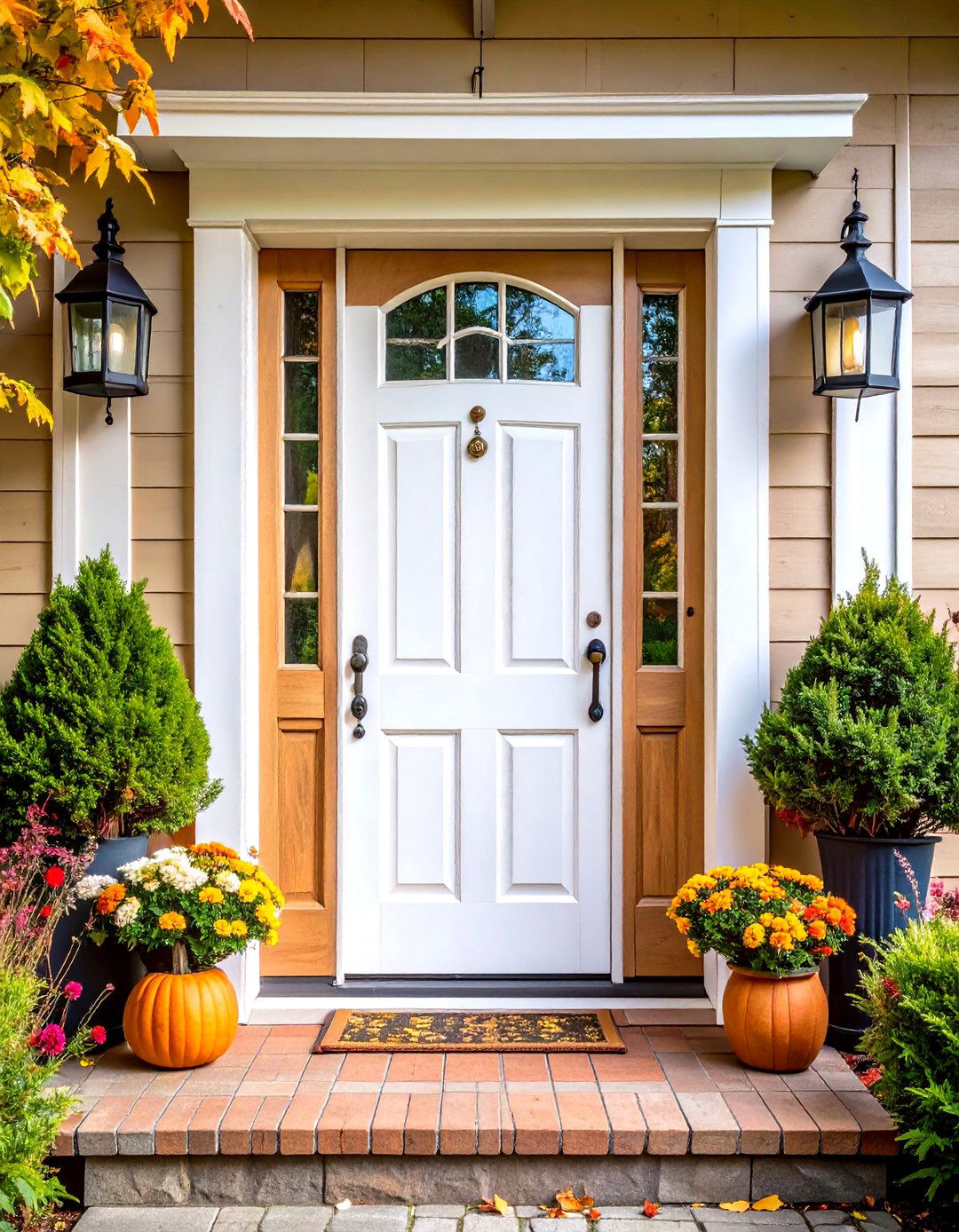
A Dutch door, often called a stable door, cuts the slab horizontally so the top leaf can open for breeze while the bottom remains closed for toddlers or pets. Crafted in white oak, the split rails resist sagging because the species’ hardness holds fasteners better than softer woods. Ask for concealed barrel bolts that lock the halves together when full closure is needed, and fit a vintage thumb-latch on the upper leaf to underscore the farmhouse vibe. Simpson Door Company highlights the way Dutch units connect indoor and outdoor spaces without compromising security. Finish both leaves with UV-blocking clear oil so the joint line ages evenly.
5. White Oak Front Door With Wrought-Iron Grille

Forged wrought-iron overlays contrast beautifully with white oak’s pale biscuit tone, creating an entry that feels both fortified and artisanal. Commission a grille pattern that echoes balcony railings or lantern brackets for cohesion, then mount it over insulated clear glass so you gain ventilation when the interior glass panel tilts inward. The oak stiles should be beefed up to 60 mm to carry the grille weight without warping. PlusMood features an iron-accented design where scrolling bars cast lace-like shadows across the porch at sunset—a romantic detail that costs little extra but elevates curb appeal instantly. Protect the metal with a matte black thermally cured powder coat to minimise future rust stains.
6. White Oak Front Door Paired With Transom & Sidelights
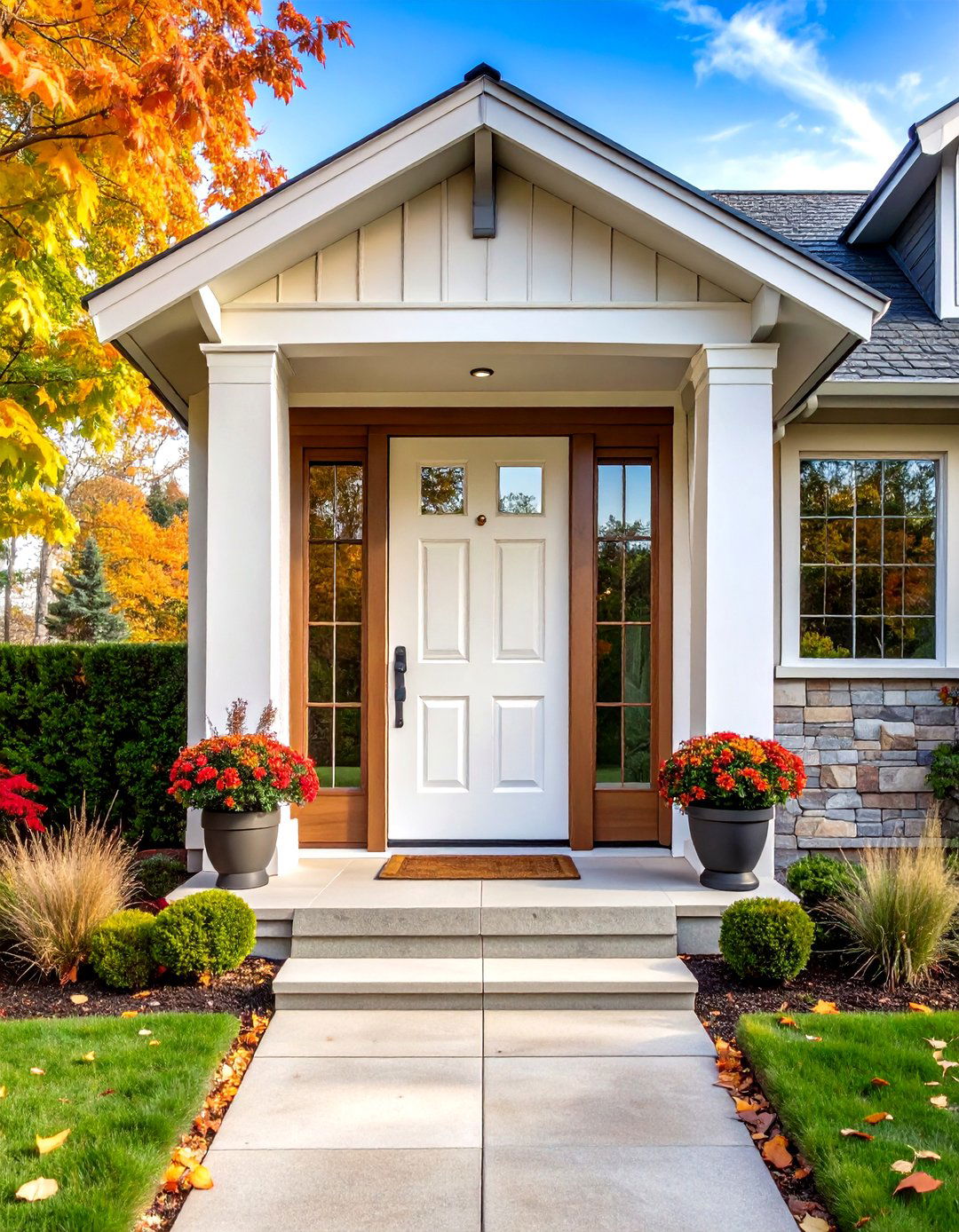
Framing your white oak slab with narrow sidelights and a matching transom enlarges the perceived foyer without widening structural openings. Trim the lite surrounds in the same oak species so the assembly reads like bespoke furniture rather than an add-on. Order low-E argon-filled glass to curb heat gain; the warm wood will offset any slight blue tint from the coating. Interior designers recommend echoing the muntin pattern in entry hall millwork for continuity. PlusMood’s double-door example demonstrates how the additional glazing softens solid oak and allows porch lights to glow through the night for a welcome beacon home. Finish the transom with hidden LED strips to highlight the grain after dusk.
7. White Oak Front Door In Natural Clear Stain
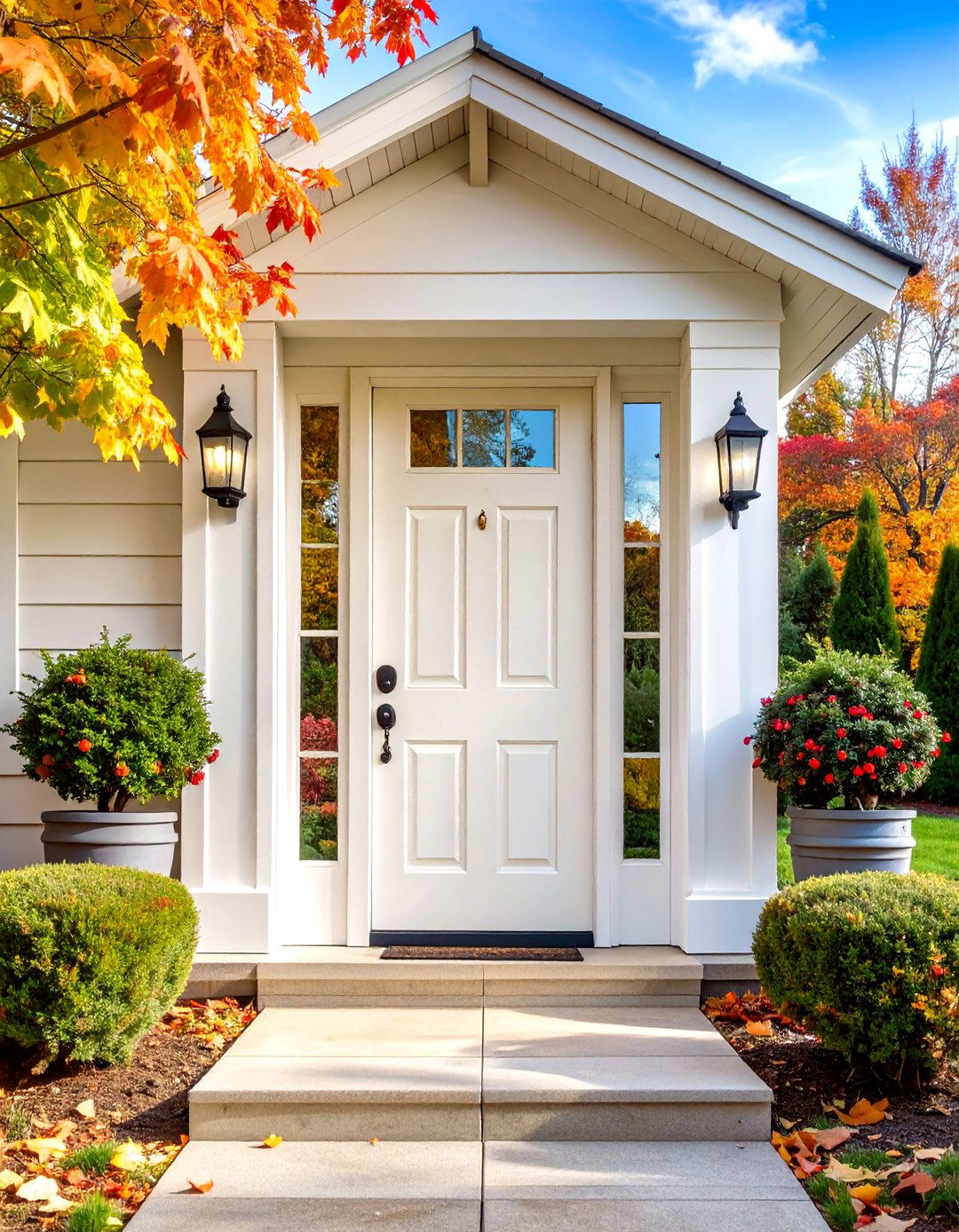
Sometimes the best finish is almost no finish at all. A penetrating clear oil-based stain followed by marine spar varnish showcases white oak’s flake and ray figure, turning the door into a live piece of art. Woodwork Haven’s exterior-finish guide notes that clear coats move with the timber, slowing the micro-cracks that lead to water ingress. The trick is disciplined maintenance: a light sanding and fresh coat every two years in full sun zones. Pair the door with satin brass hardware to pick up the honey tones emerging as the varnish ages. Mount weatherstripping before the finish cures to avoid later cutting into the sealer.
8. White Oak Front Door With Charred Shou Sugi Ban Finish
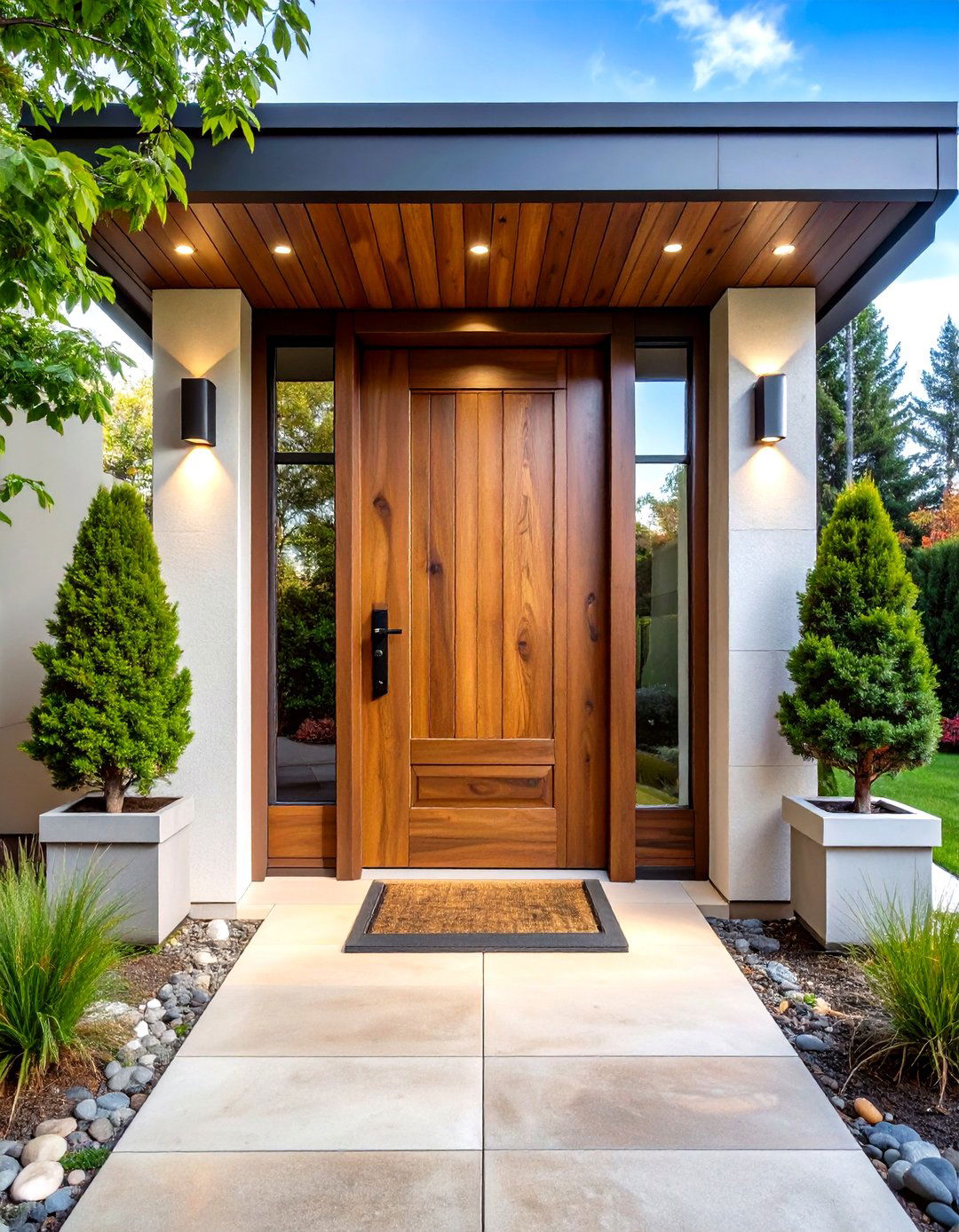
Channel Japanese Yakisugi by lightly torching the surface of quarter-sawn white oak until it reaches a rich espresso hue, then brushing away loose char and sealing with tung oil. The fire carbonizes cellulose, increasing rot resistance while yielding dramatic texture. WoodThrive explains that Shou Sugi Ban adds decades of service life and delivers near-zero maintenance once oiled. The Spruce adds that charring makes hardwoods more insect-resistant and provides a striking backdrop for modern black fixtures. Pair the dark slab with crisp white stucco walls so its deep ridges pop, and install uplights to graze the relief after sunset. Request a wire-brushed texture before burning to exaggerate the cathedral grain pattern under the soot.
9. White Oak Front Door With Chevron Inlay
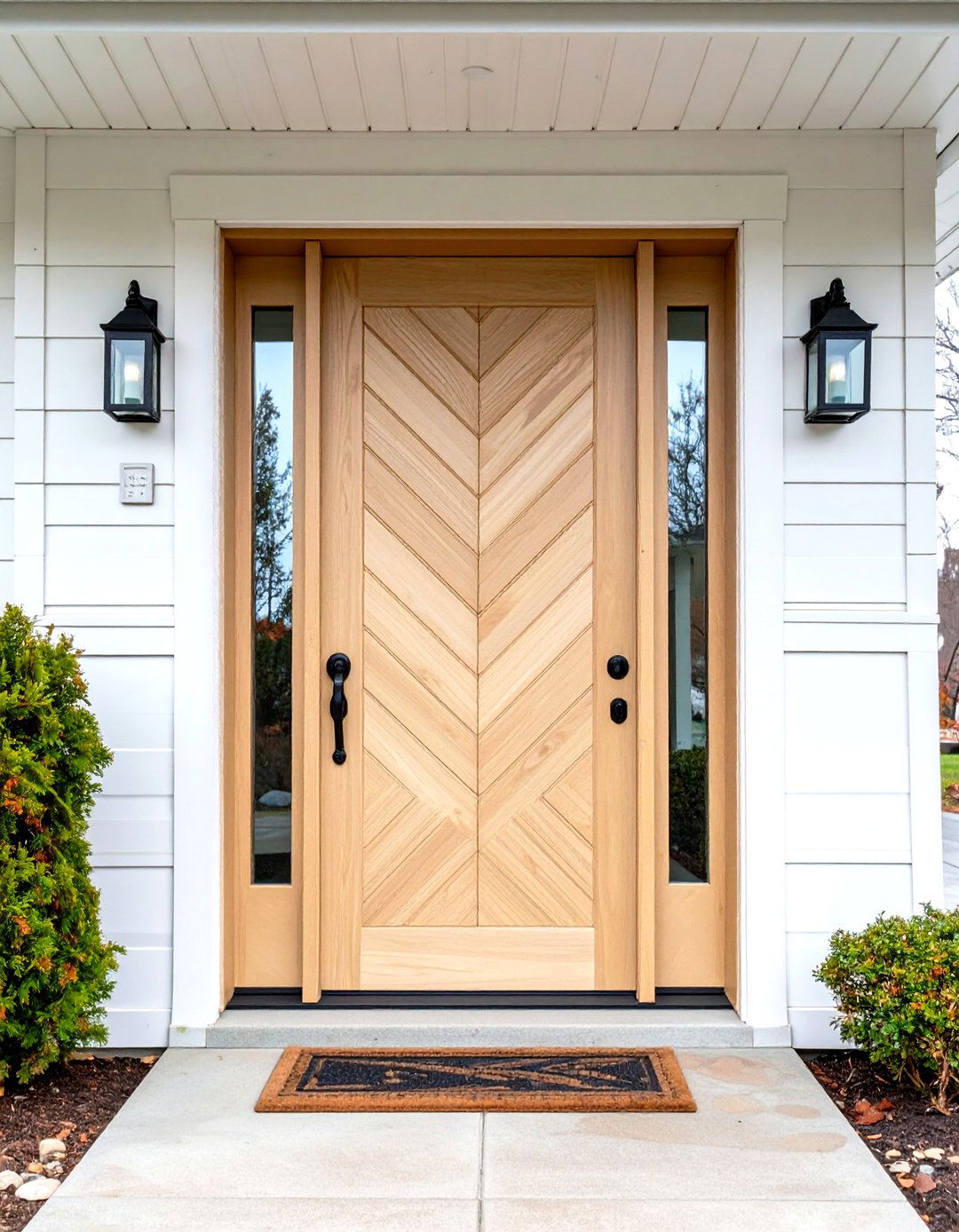
Angling short staves at forty-five degrees to meet in the center creates a bold chevron that introduces movement without additional color. Lay the pattern over a stable plywood core to reduce seasonal shift, and specify shop-pressed veneer so the joints stay flush. Fill the V-grooves with contrasting black epoxy for a crisp graphic line that won’t collect dust. PlusMood features a similar chevron door where matte black hardware echoes the inlay and transforms an otherwise neutral façade into a contemporary showpiece. Install concealed pivot pins to keep the zigzag uninterrupted by visible hinges, and seal with satin polyurethane to balance sheen between oak and epoxy.
10. White Oak Front Door With Arched Top

An arched head instantly softens rigid façades, and white oak’s strength allows the curved stiles to be milled from a single laminated blank, preventing weak cross-grain joints. A cottage remodel featured in Southern Living shows how the arched white oak entry, paired with copper lanterns, created a welcoming, heirloom quality focal point. Keep muntins slim so the arch remains the hero, and add a keystone-shaped escutcheon at handle height to echo the curve. Because curved jambs are trickier to weather-seal, specify a compressible bulb gasket that follows the radius and keeps monsoon windblown rain outside. Stain with medium walnut to accentuate the bend and highlight cathedral rays.
11. White Oak Front Door With Oversized Pull Handle
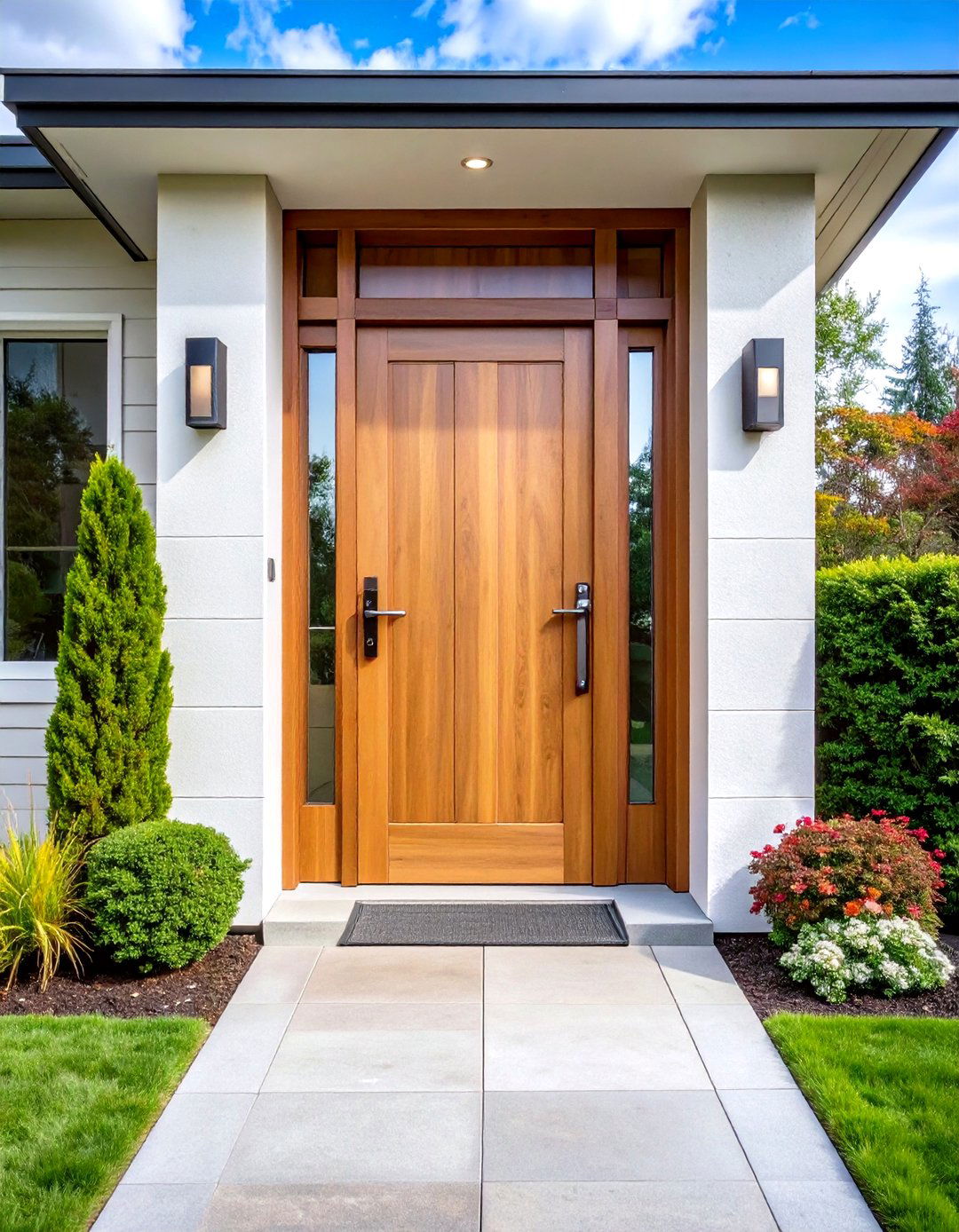
Large-scale architectural hardware transforms a plain slab into a sculptural statement. BH&G’s 2025 curb-appeal guide notes that elongated handles are trending because they match the growing height of contemporary entries. Pair a 900 mm brushed-bronze pull with a concealed magnetic latch so the handle becomes the only visible element. Because white oak tolerates compression screws well, through-bolting the pull will not crush fibers, ensuring a solid, wiggle-free feel. Center the handle slightly above midline to align with average shoulder height, and balance its mass with an understated rain-chain instead of a bulky porch column planter. Opt for PVD coating to prevent coastal salt tarnish on the bronze.
12. White Oak Front Door Factory-Prehung For Energy Efficiency
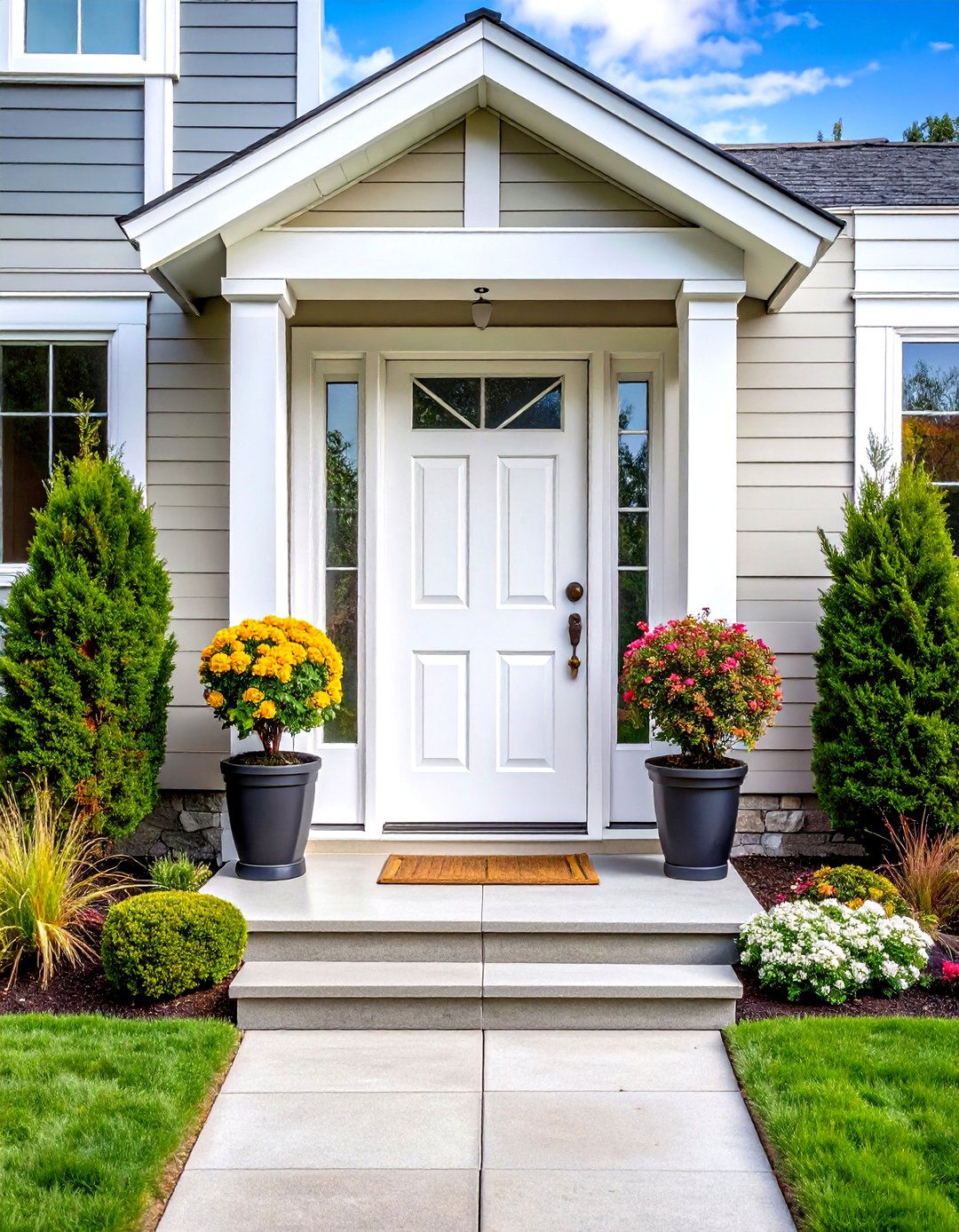
Ordering a factory-prehung white oak door ensures the weatherstripping, sill, and threshold are precision-fit in a controlled environment, eliminating the gaps that notorious DIY installs leave behind. Vufold’s thermal-efficiency guide lists wood’s natural insulating value and shows how oak slabs with insulated cores can reach U-values under 1.2 W/m²K. Combine that performance with Value Doors’ advice on adding sweeps and compression seals to cut draft leakage by up to 30 percent. Ask for jambs flashed with butyl membrane to avoid water wicking, and select a low-profile adjustable aluminum sill so wheelchair users can cross the threshold comfortably. Finish the frame interior with foam backer rod before trim for even higher R-value.
13. White Oak Front Door With Integrated Smart Lock
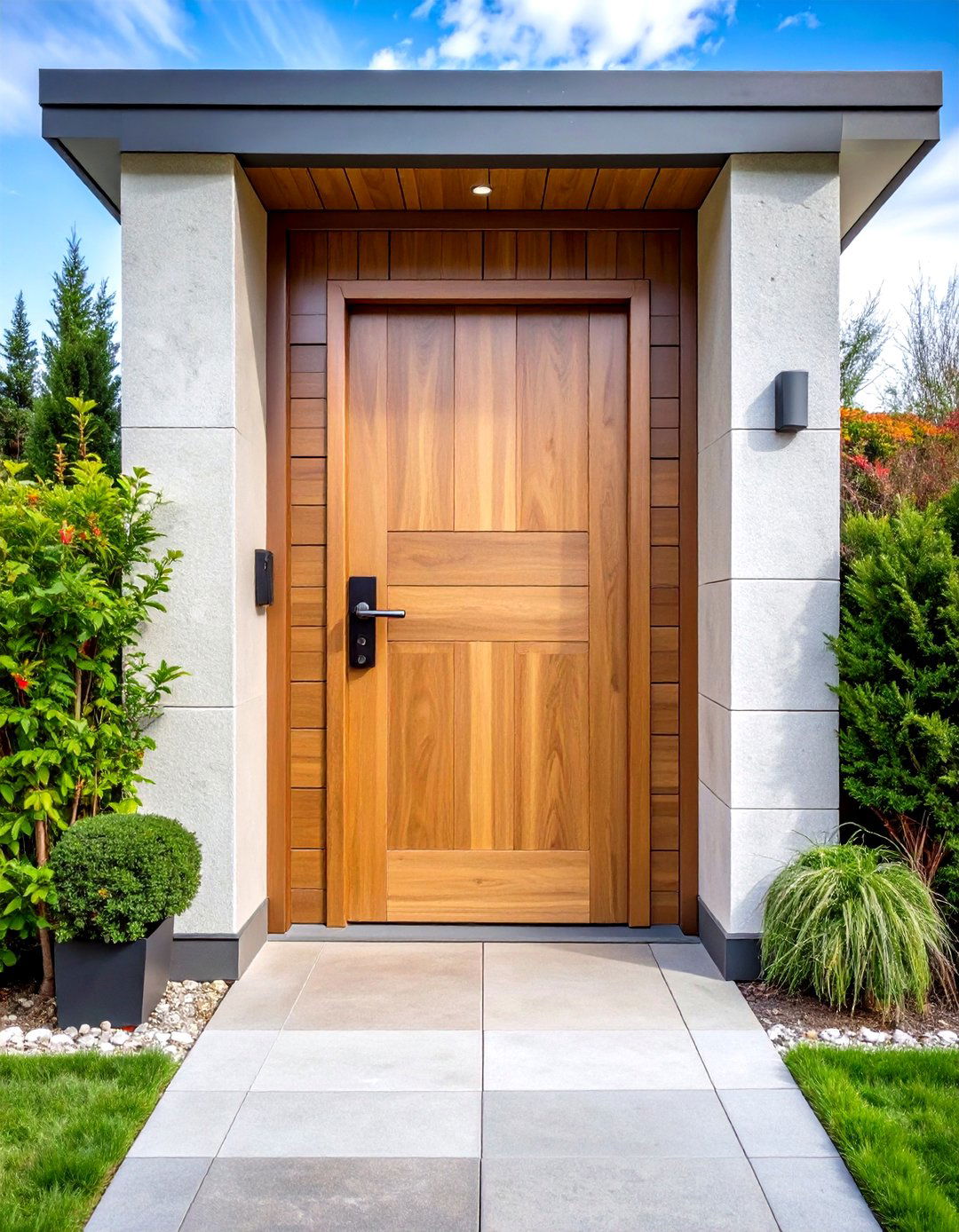
Smart locks no longer require bulky keypad escutcheons. Many 2025-ready systems hide batteries and motors inside a minimalist pull, a trend BH&G highlights in its latest curb-appeal roundup. Drilling white oak for the mortise pocket is straightforward because the tight grain resists tear-out, but remember to seal the hollow with polyurethane to prevent moisture from shorting electronics. Choose a model featuring NFC and fingerprint unlock so family members need no phone to enter. For a cohesive look, specify a matching smart door viewer that syncs with the same app, giving you full entry monitoring without visual clutter. Ensure batteries remain accessible through a concealed edge cap for quick swaps.
14. White Oak Front Door With Frosted Privacy Glass
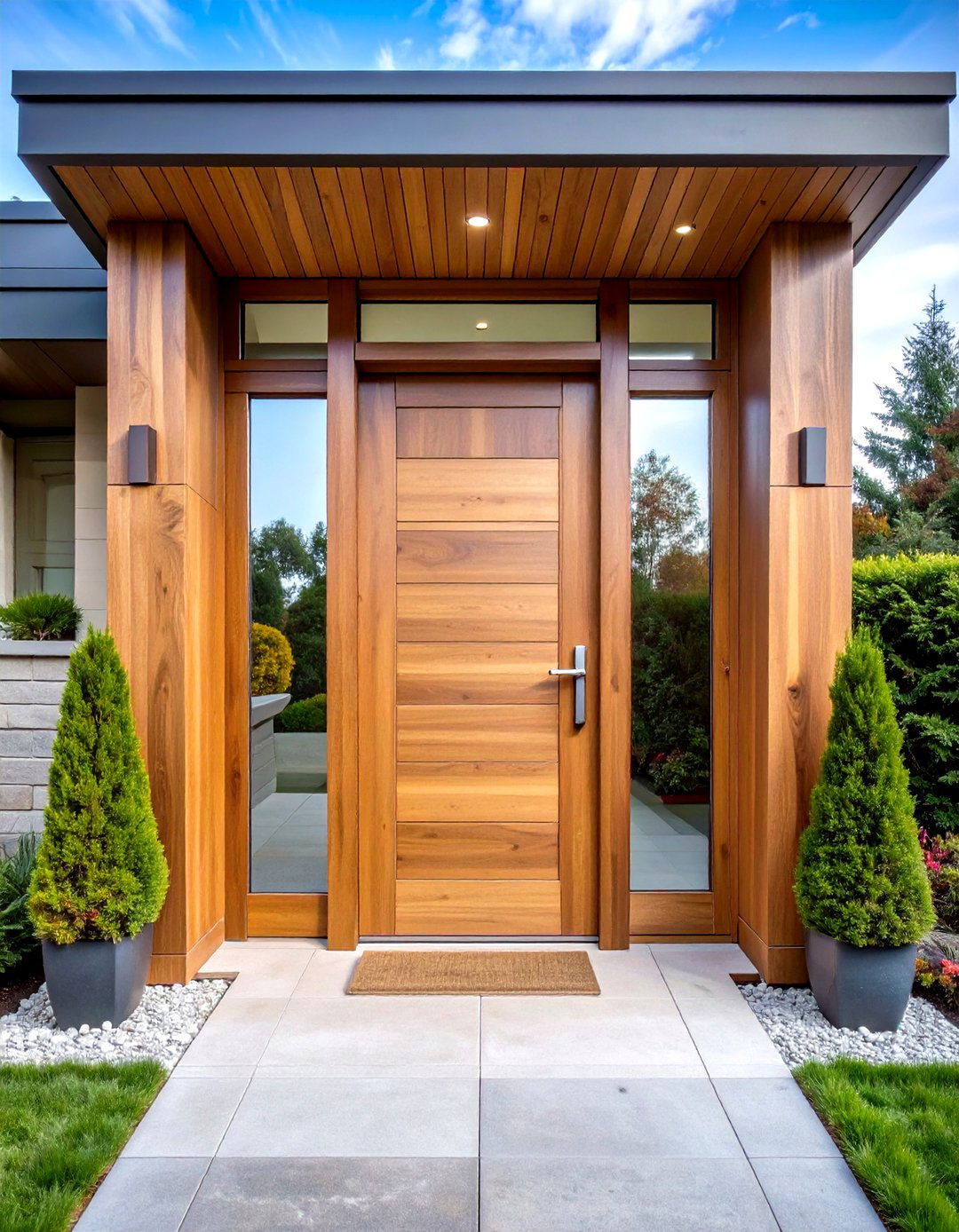
Frosted glass diffuses harsh streetlights yet still bathes your hallway in a soft glow. Frame the opaque panels with white oak rails so the timber outlines read like picture frames around shifting light. PlusMood’s idea pairs frosted lites with minimalist hardware to achieve spa-like serenity. To maximise performance, follow Value Doors’ insulation tips and specify insulated frosted units that sandwich the etched surface inside the IGU; this prevents fingerprints on interior faces and boosts energy savings. Finish the door in a matte clear coat to avoid glare competing with the diffuse glass sheen. Install dimmable wall sconces to let the frosted panes become evening lanterns.
15. White Oak Front Door With Mid-Century Slatted Design
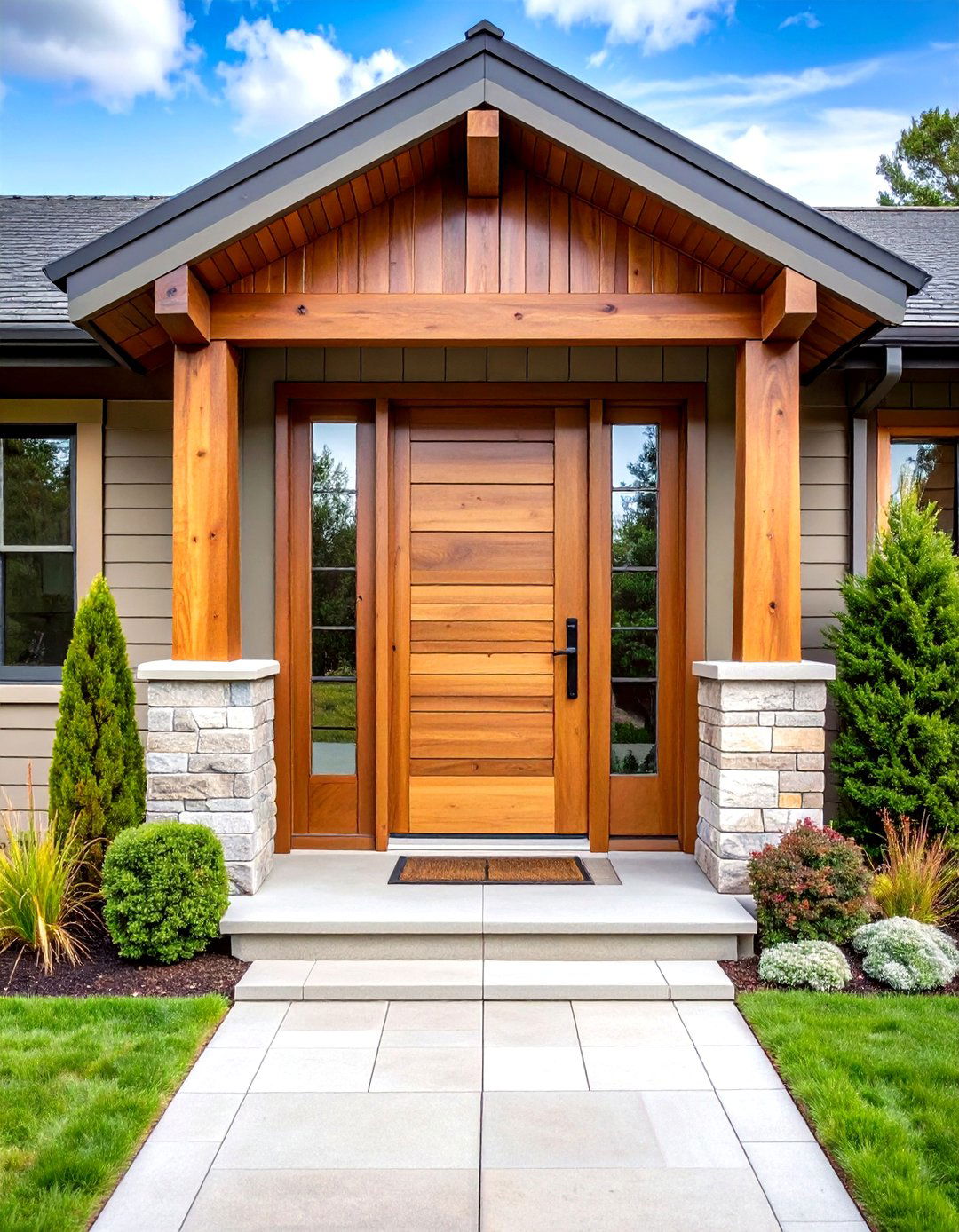
Horizontal slats separated by slim reveals evoke 1950s California ranch homes while giving modern ventilation cues. House Digest predicts that earthy materials like white oak will replace stark white façades in updated farmhouse designs for 2025, making this door an ideal bridge between periods. Mill 25 mm battens and space them 10 mm apart over a solid core, backing the gaps with black aluminium to keep weather out but depth in. A walnut-tinted oil stain tempers the oak’s paler sap streaks, and a flat-bar stainless pull mimics the grille rhythm without visual overload. Match house numbers in the same metal for cohesive mid-century punctuation.
16. White Oak Front Door With Craftsman-Style Lite Grid

Stick-built Craftsman doors typically feature a three-over-one lite arrangement; re-interpreting this in white oak delivers fresh warmth while respecting bungalow heritage. Cut muntins from quarter-sawn stock to minimise seasonal shrinkage that can expose glass edges. PlusMood’s carved white oak example shows how wide bottom rails and graceful vertical stiles ground the grid visually. Swap traditional art-glass for clear insulated panels to brighten interiors yet hold energy bills steady. Finish in a hand-rubbed medium-brown stain topped with satin urethane to emphasise ray fleck, and add oil-rubbed bronze strap hinges for authentic period flair. Install a dentil shelf under the lite row for extra Craftsman character.
17. White Oak Front Door With Warm Walnut-Tone Stain

Owing to its open pores, white oak accepts dark stains uniformly, allowing you to mimic pricier walnut without losing oak’s superior weathering. Apply a gel stain followed by UV-resistant waterborne topcoat, as recommended in Woodwork Haven’s finish comparison chart. The deeper tone works beautifully with aged copper gutters and dark bronze fixtures, bringing cohesion to eclectic exteriors. Before staining, raise the grain with a damp cloth and lightly sand to prevent post-finish fuzz. Because darker hues absorb more heat, specify insulated glass and a reflective roof overhang to moderate thermal expansion cycles. Annual oil refreshes maintain color depth without stripping previous coats.
18. White Oak Front Door With Coastal Whitewash Finish
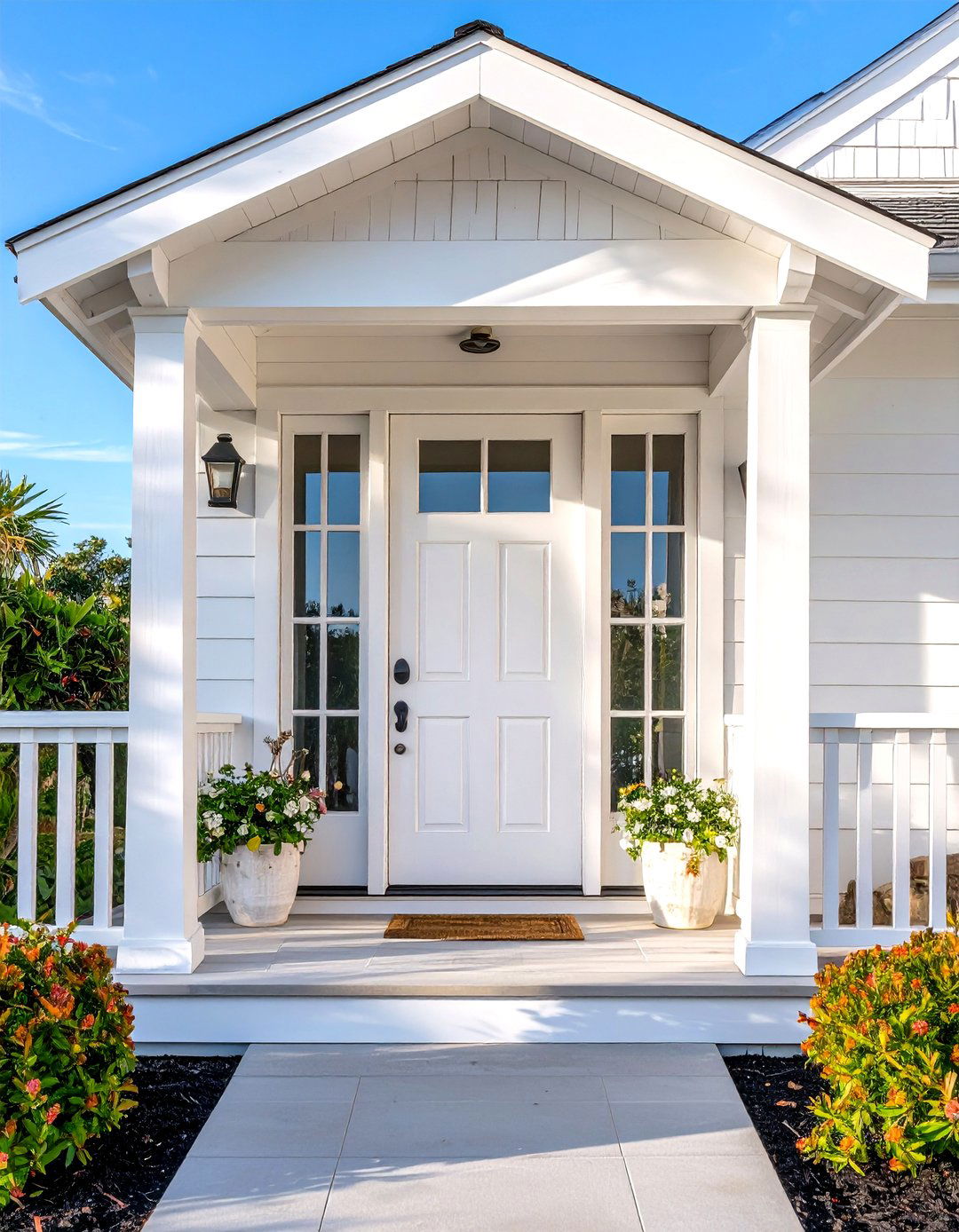
A translucent whitewash lends laid-back beach-house vibes while still showcasing the medullary rays that make white oak so prized. Brush on an acrylic lime-wash, wipe back after three minutes, then seal with matte exterior polyurethane to lock in the sun-bleached look. PlusMood’s black-trimmed white oak door proves the contrast between pale wood and dark surrounds feels crisp rather than nautical cliché. Coordinate the entry with brushed nickel hardware and driftwood planters for a cohesive palette, and add a coconut-fiber door mat so wind-blown sand doesn’t abrade the soft pickled finish. Reapply wash every five years to keep the airy patina consistent.
19. White Oak Front Door With Statement Color Contrast Trim
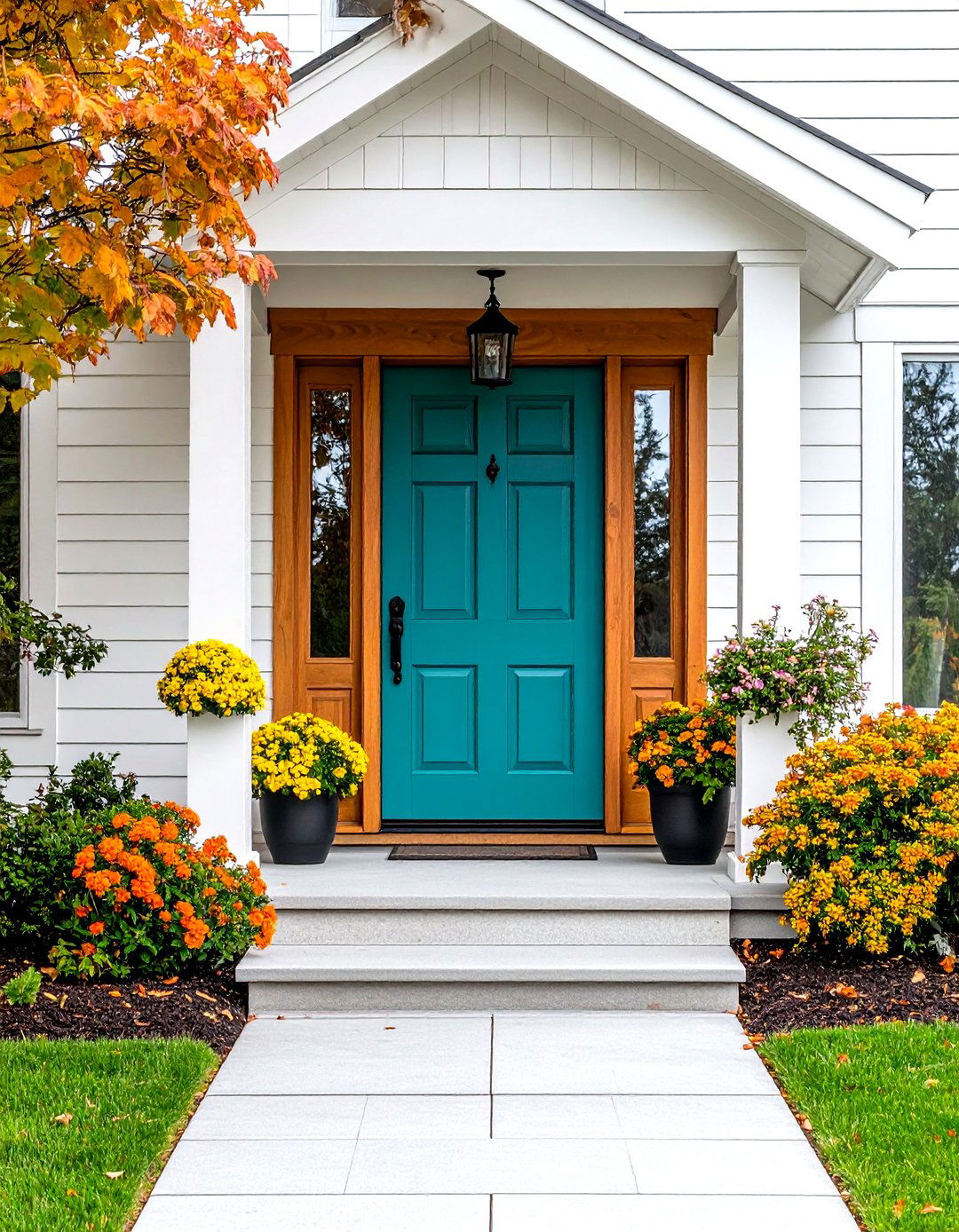
Painting only the casing and trim in a daring hue—think terracotta or deep teal—frames your natural white oak door like gallery art. BH&G reports a surge in bold, earth-toned contrasts that draw the eye while letting wood stay unpainted. Mask the slab carefully and use high-build acrylic enamel so the color line stays razor sharp. Echo the accent shade in porch pots or mailbox numbers for cohesive repetition, and finish the oak with low-sheen sealer so it doesn’t compete. This strategy lets adventurous homeowners experiment with color without risking regret over hiding beautiful grain. Choose UV-stable pigments to resist fading in summer sun.
20. White Oak Front Door From Reclaimed Barn Beams

Salvaging white oak beams from century-old barns gives you a door packed with history and tight, stable grain that newer lumber can’t match. Mill the reclaimed timber into 50 mm boards, leaving original saw marks and nail scars for authenticity. LSC Manufacturing’s maintenance guide suggests applying penetrating oil that soaks into aged fibers, reducing the risk of checking while preserving patina. PlusMood’s rustic distressed door shows how reclaimed material pairs naturally with wrought-iron hinges and stone surrounds. Add a concealed steel sub-frame for security, and install a wide threshold so the heavier slab clears finished floors without dragging. Fit adjustable tension hinges to fine-tune closing speed despite the weight.
Conclusion:
White oak’s adaptability lets you move from sleek modern pivot to reclaimed-beam rustic without changing species. These twenty ideas show how thoughtful joinery, finishes, and hardware decisions can customise the same durable timber for any architectural language, all while boosting energy performance and resale-ready curb appeal.


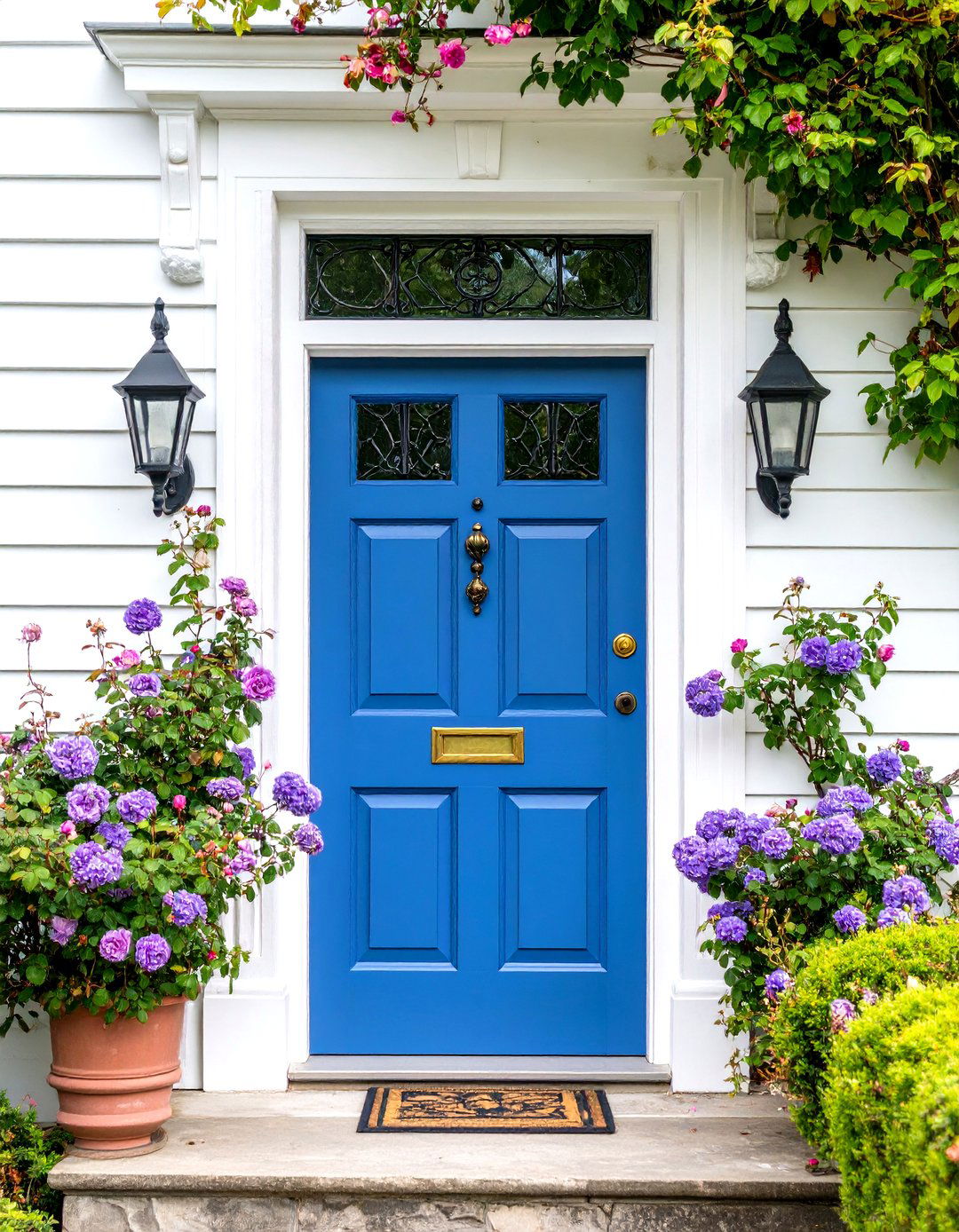
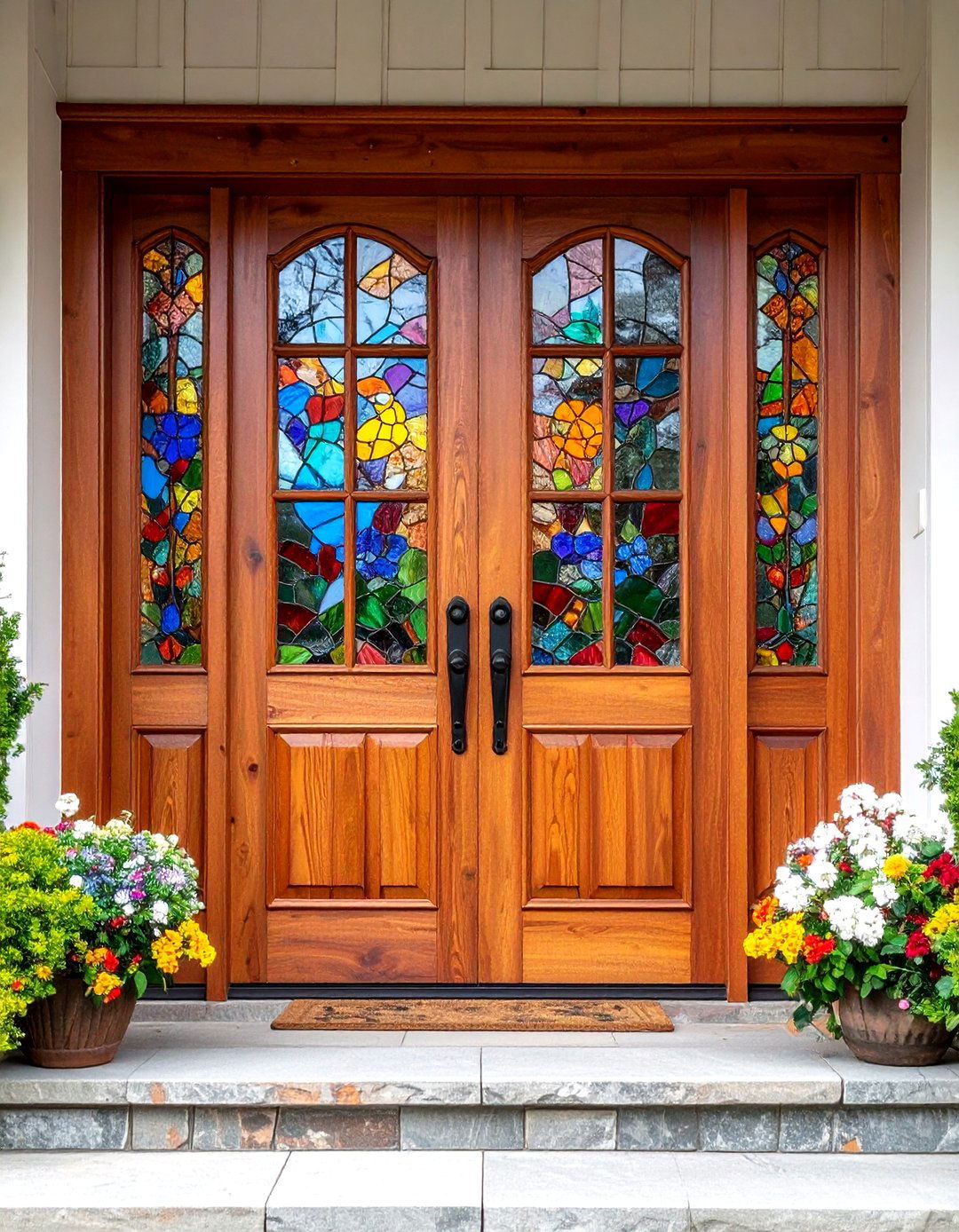

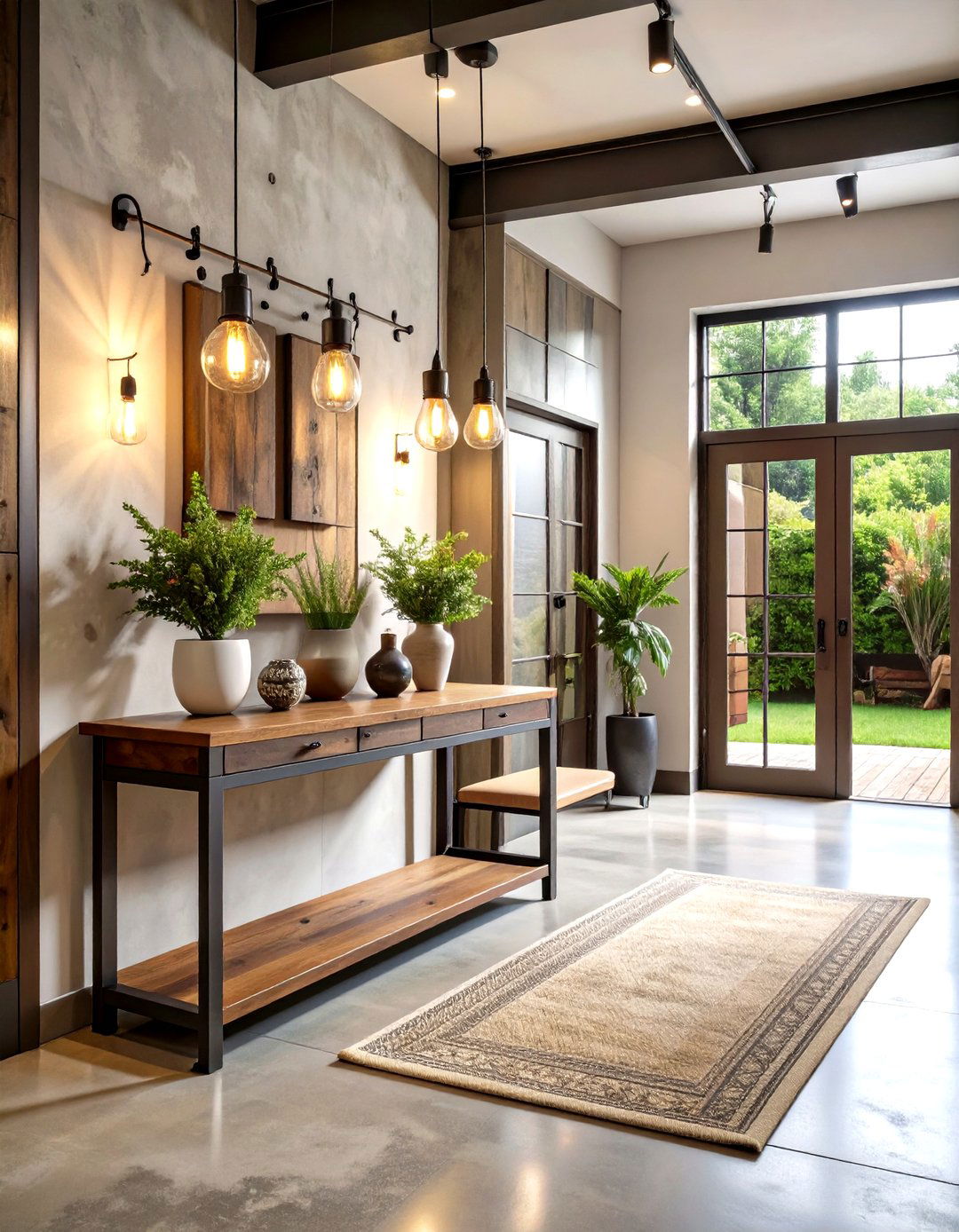

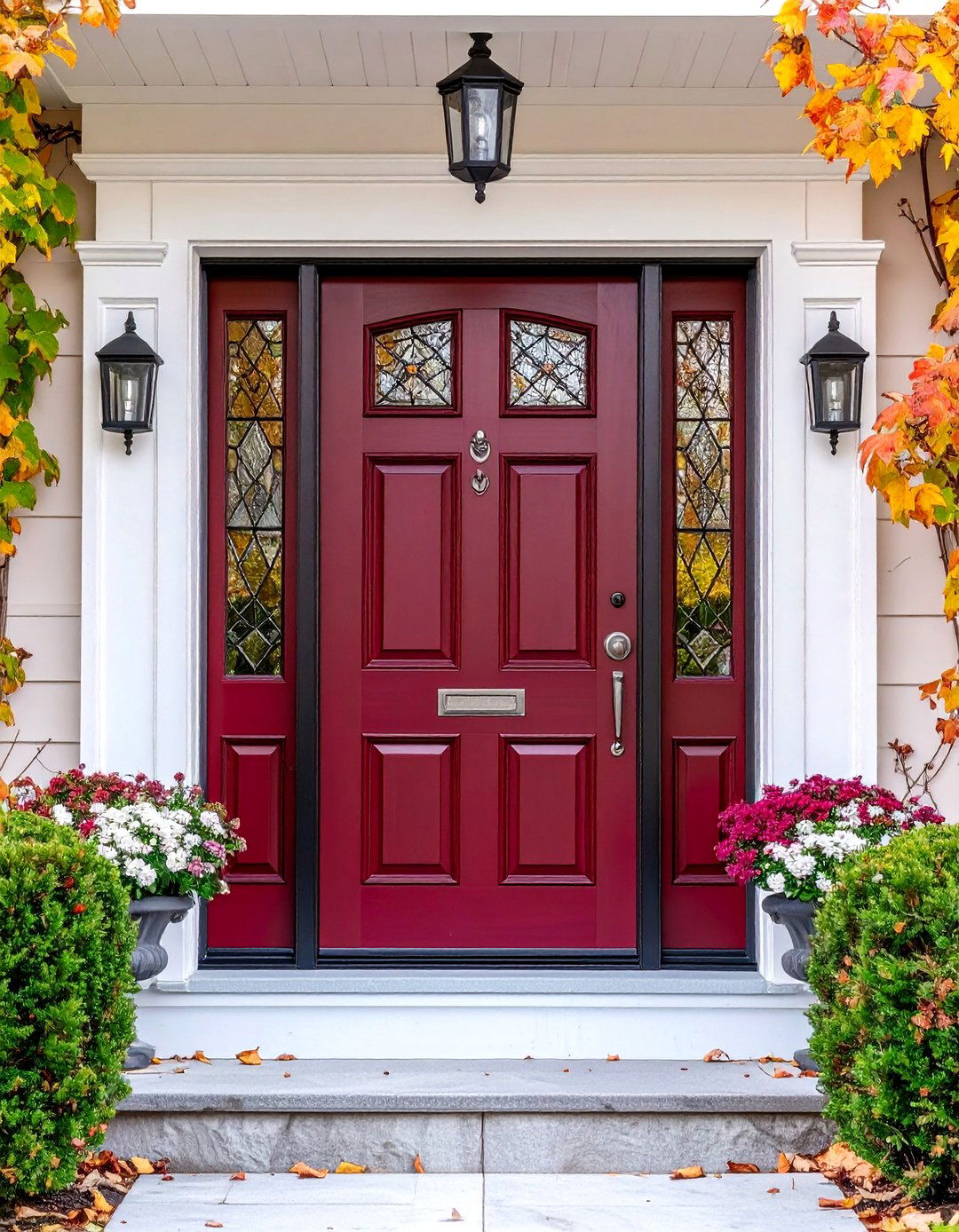
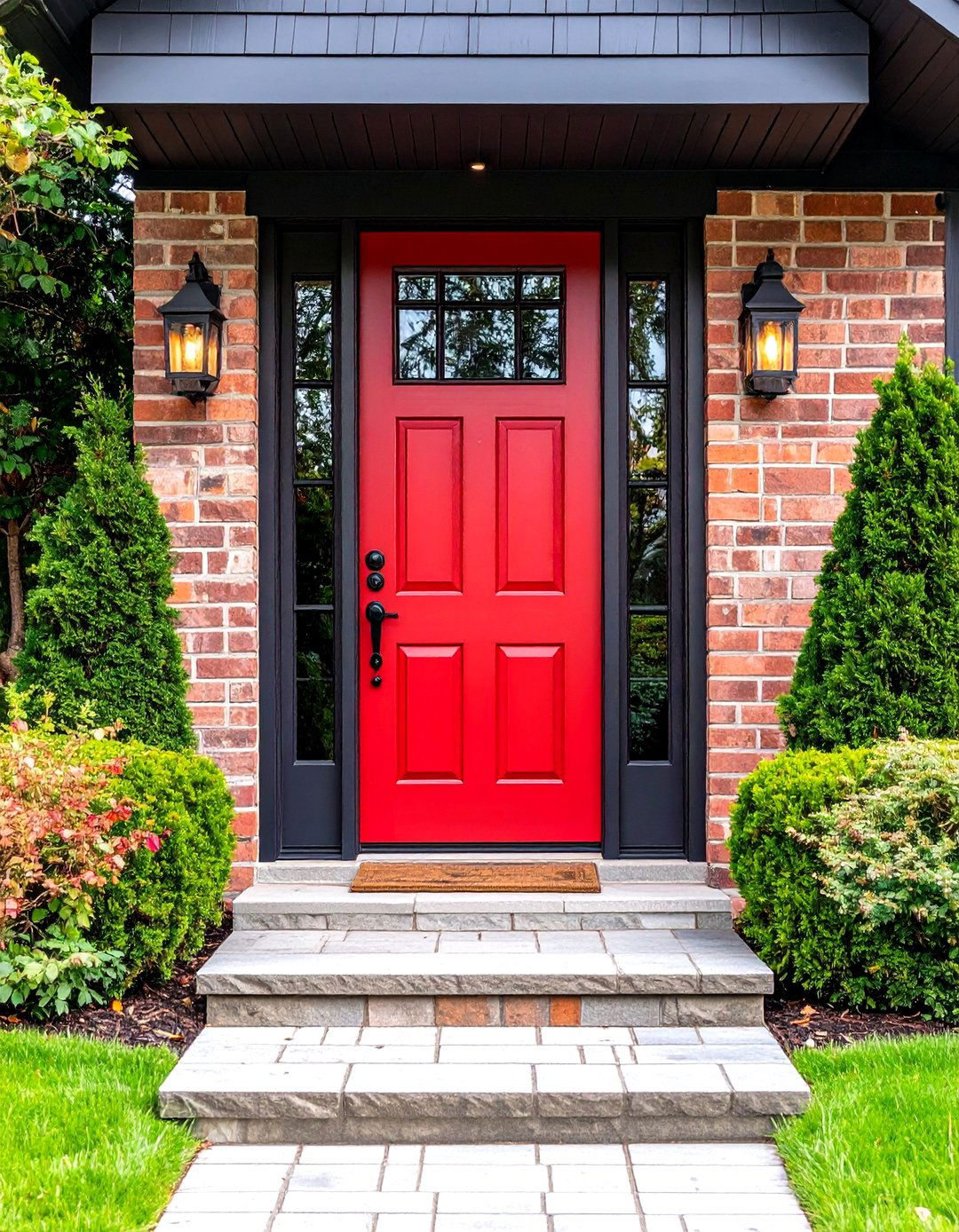
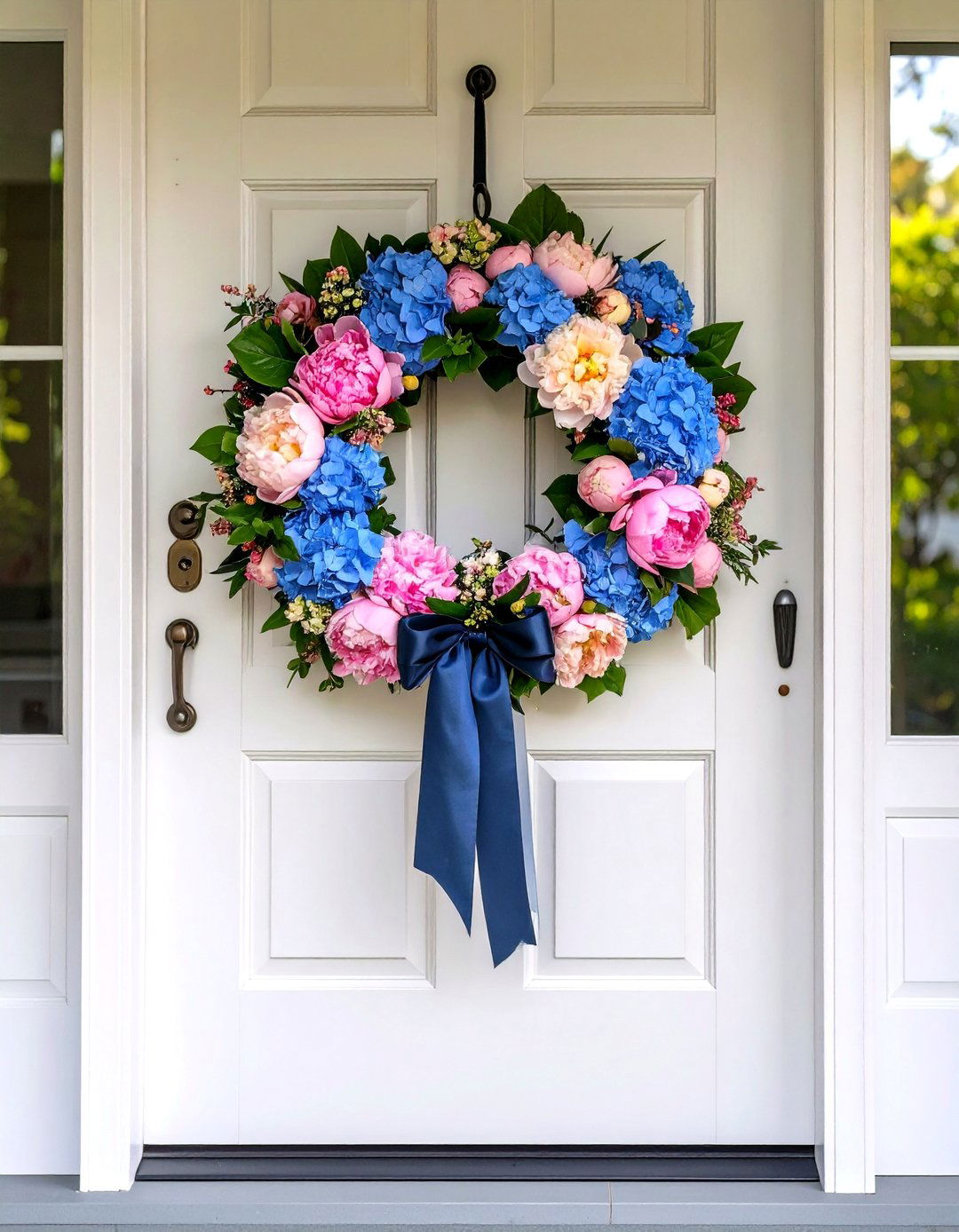
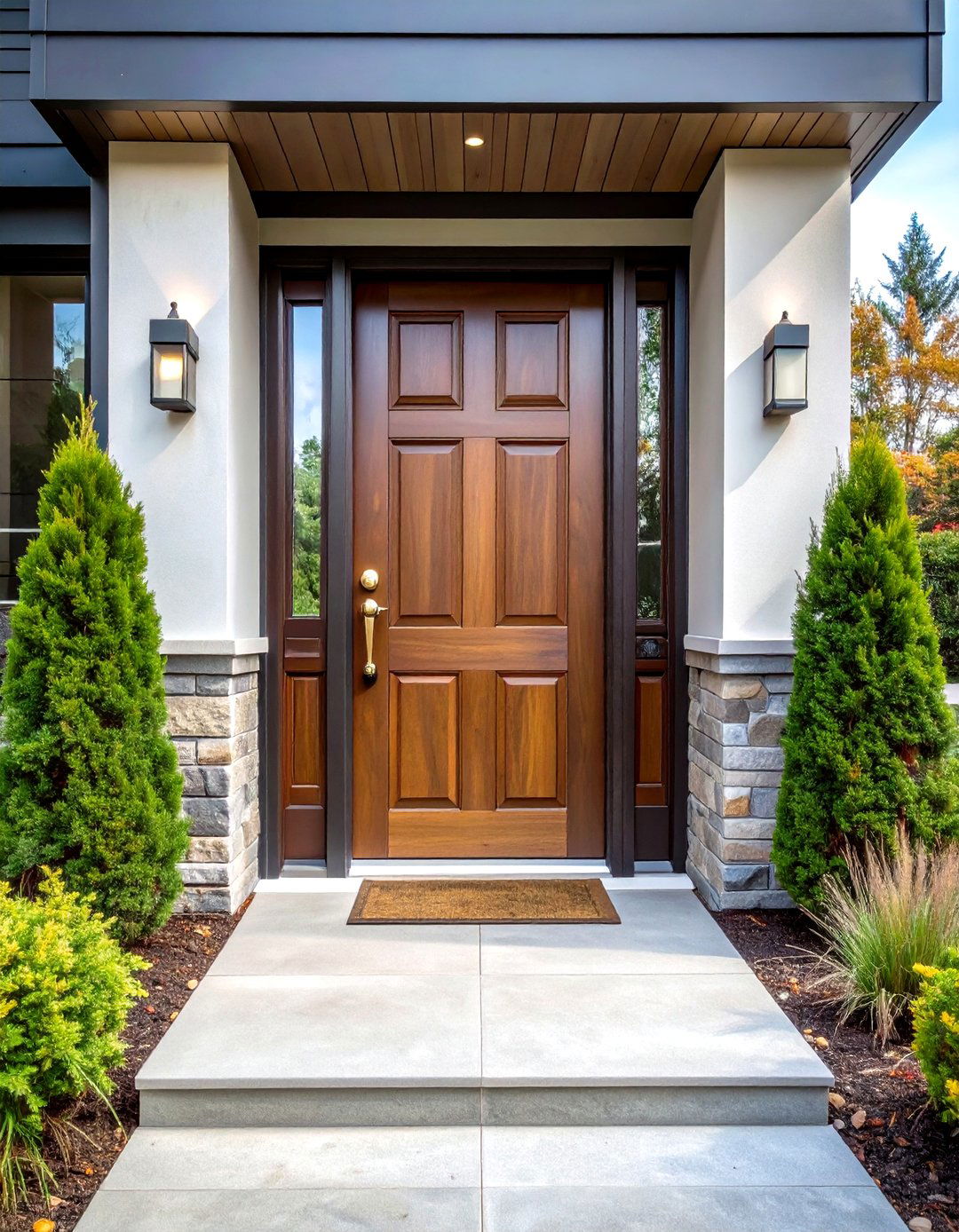
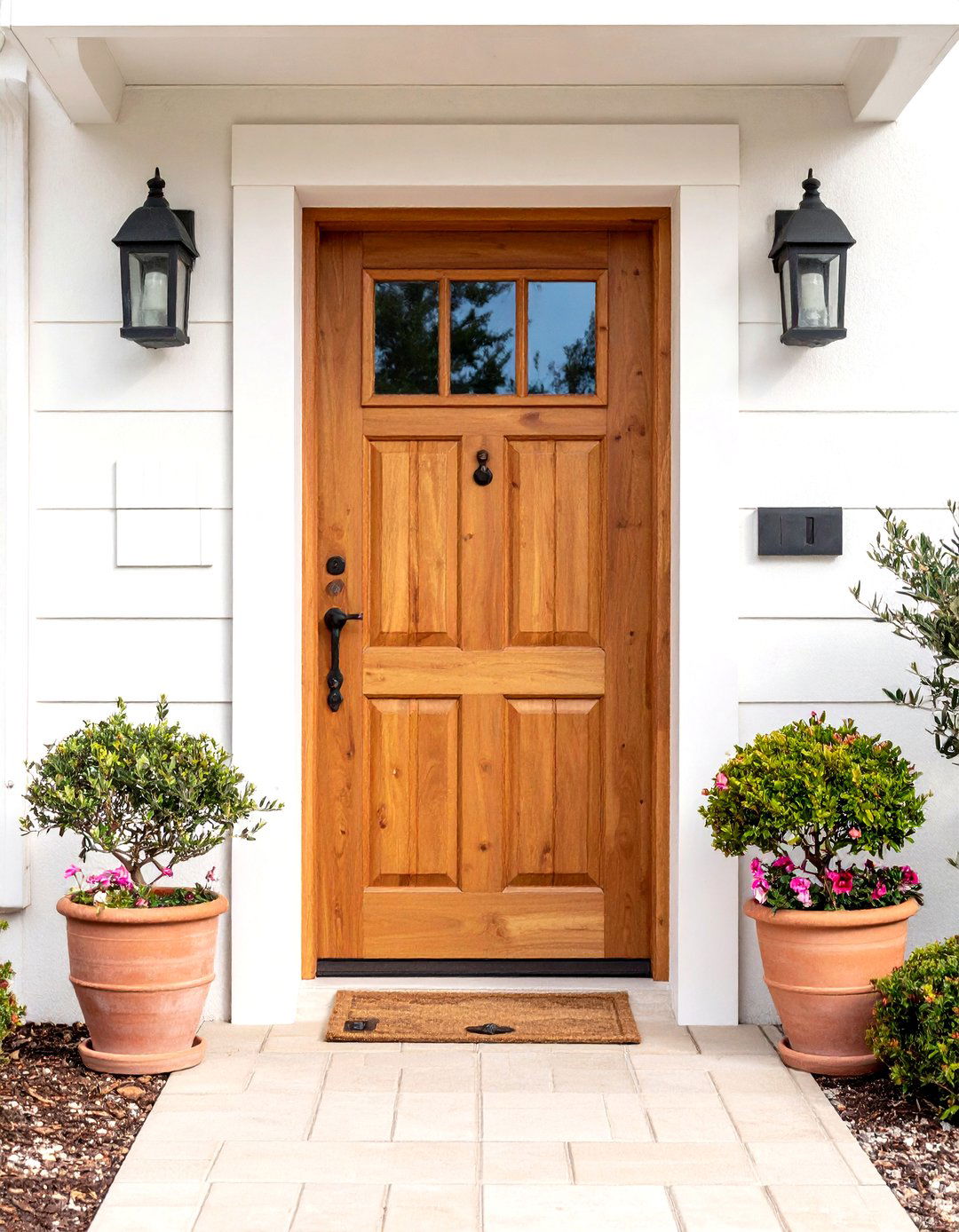
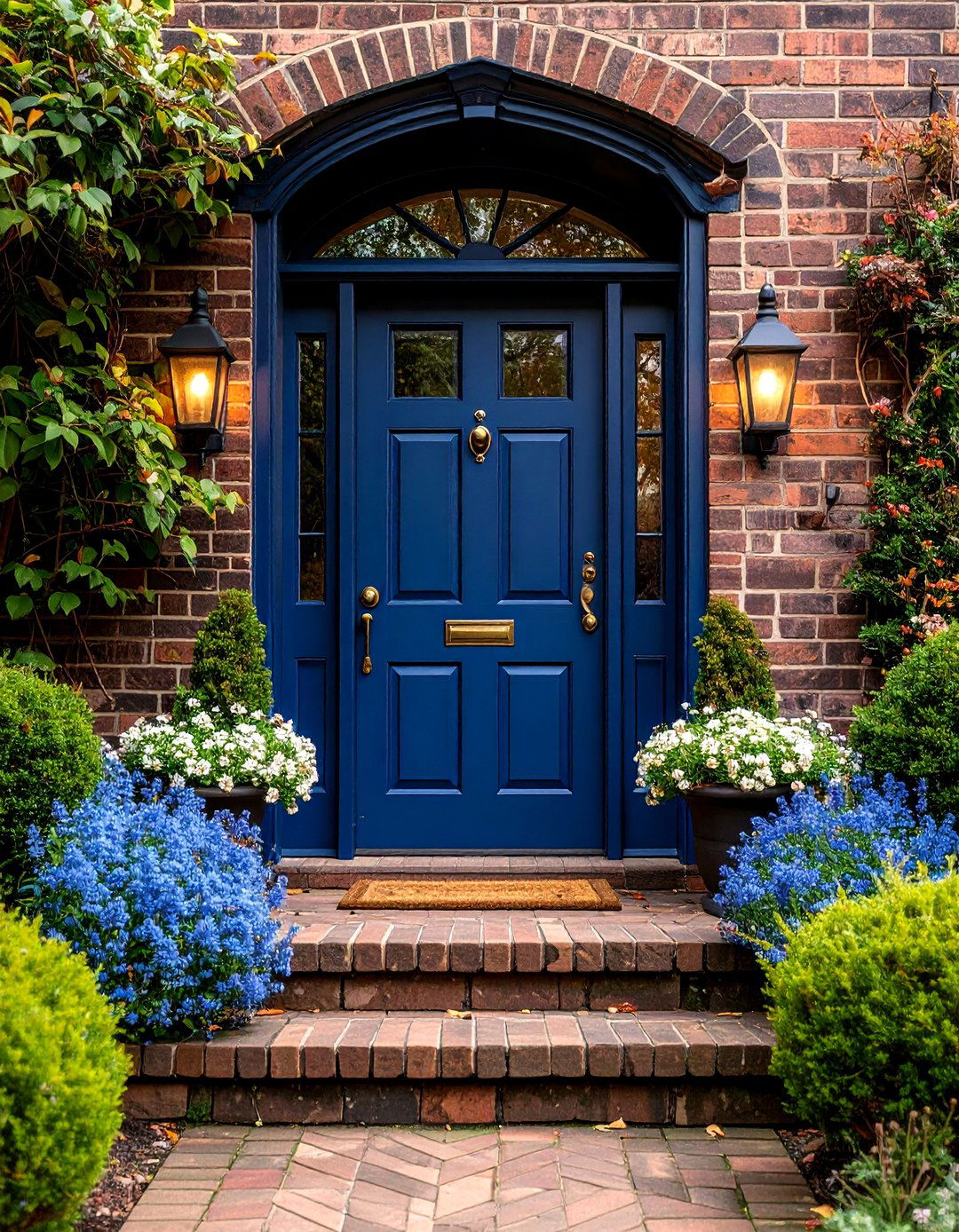
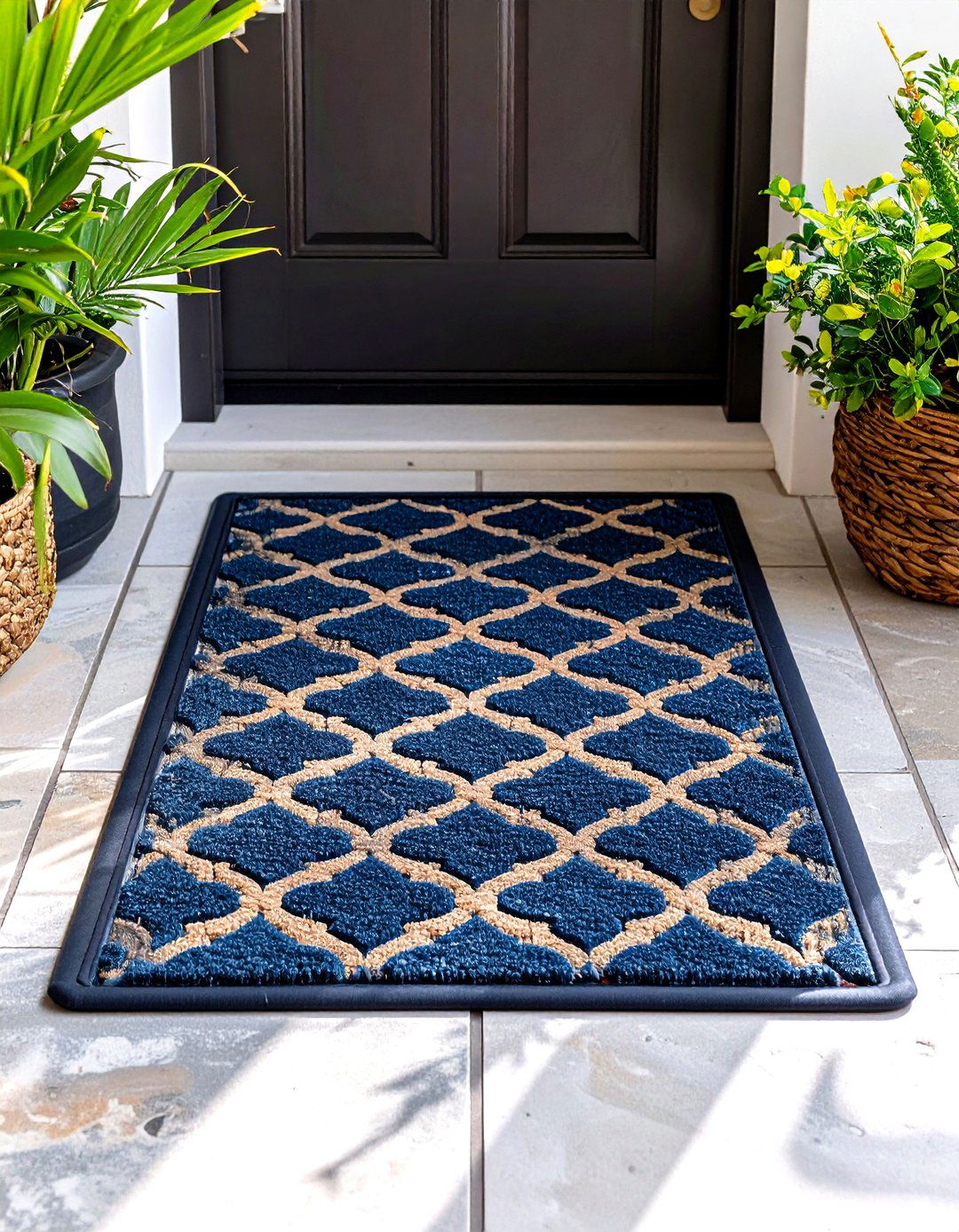
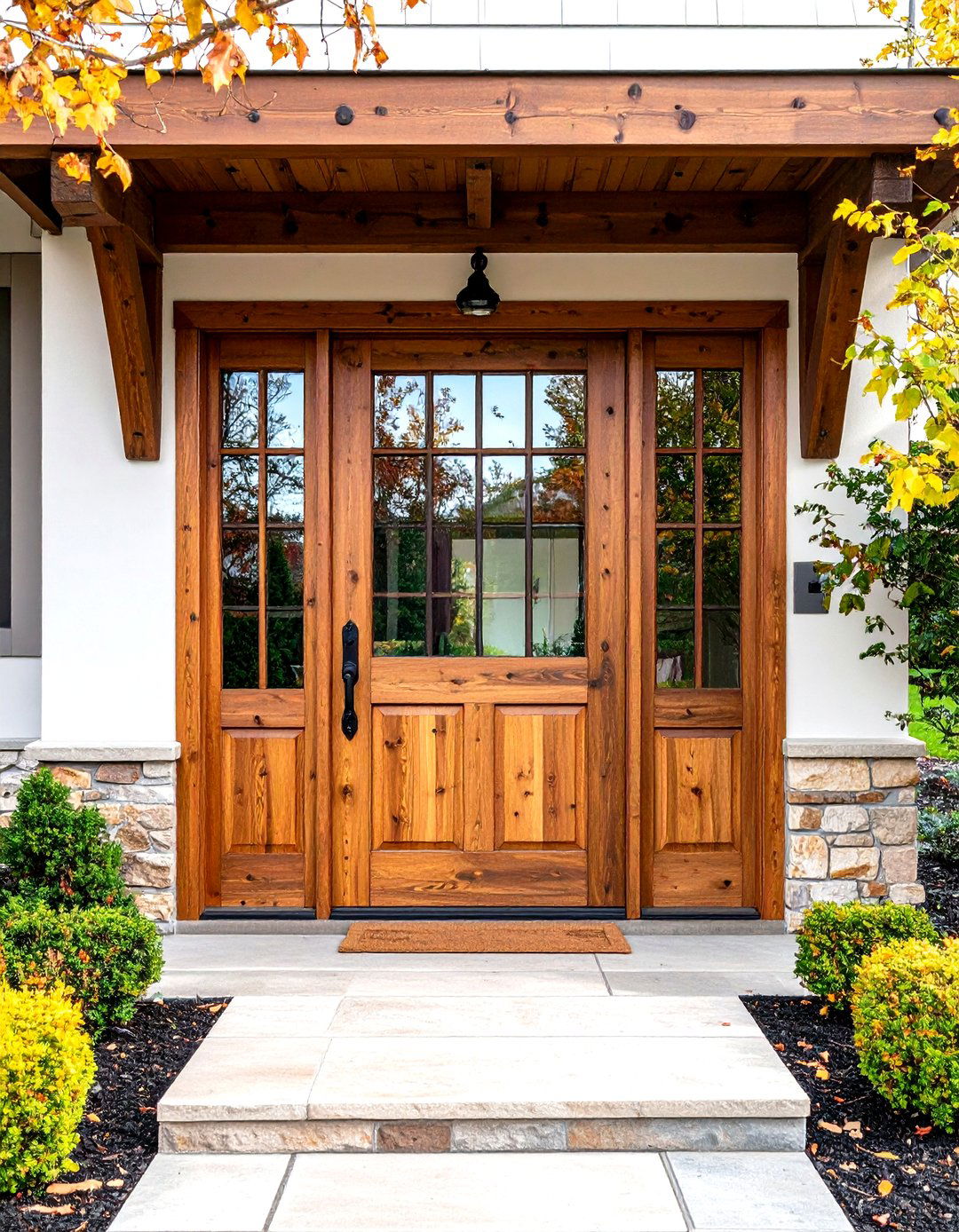
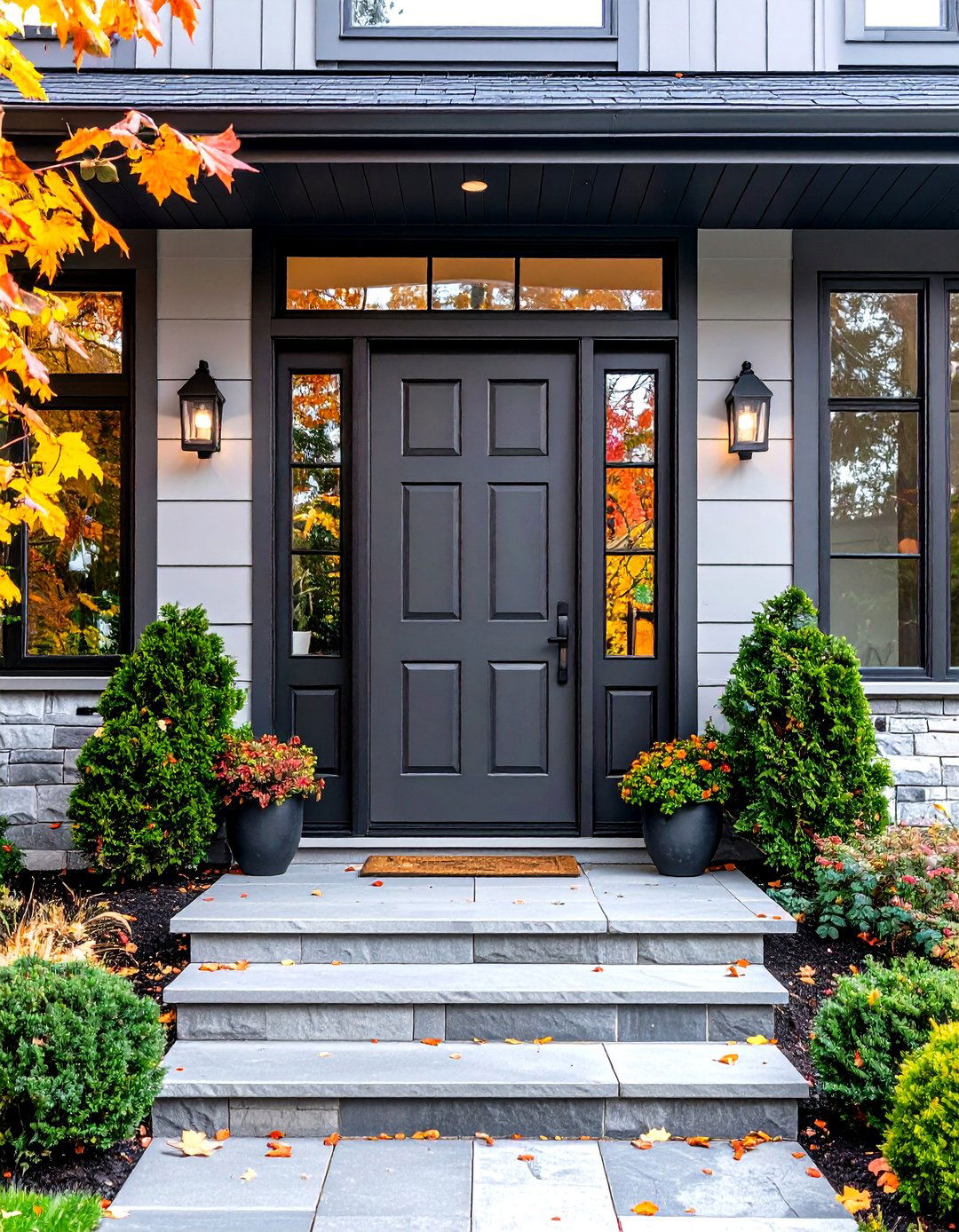
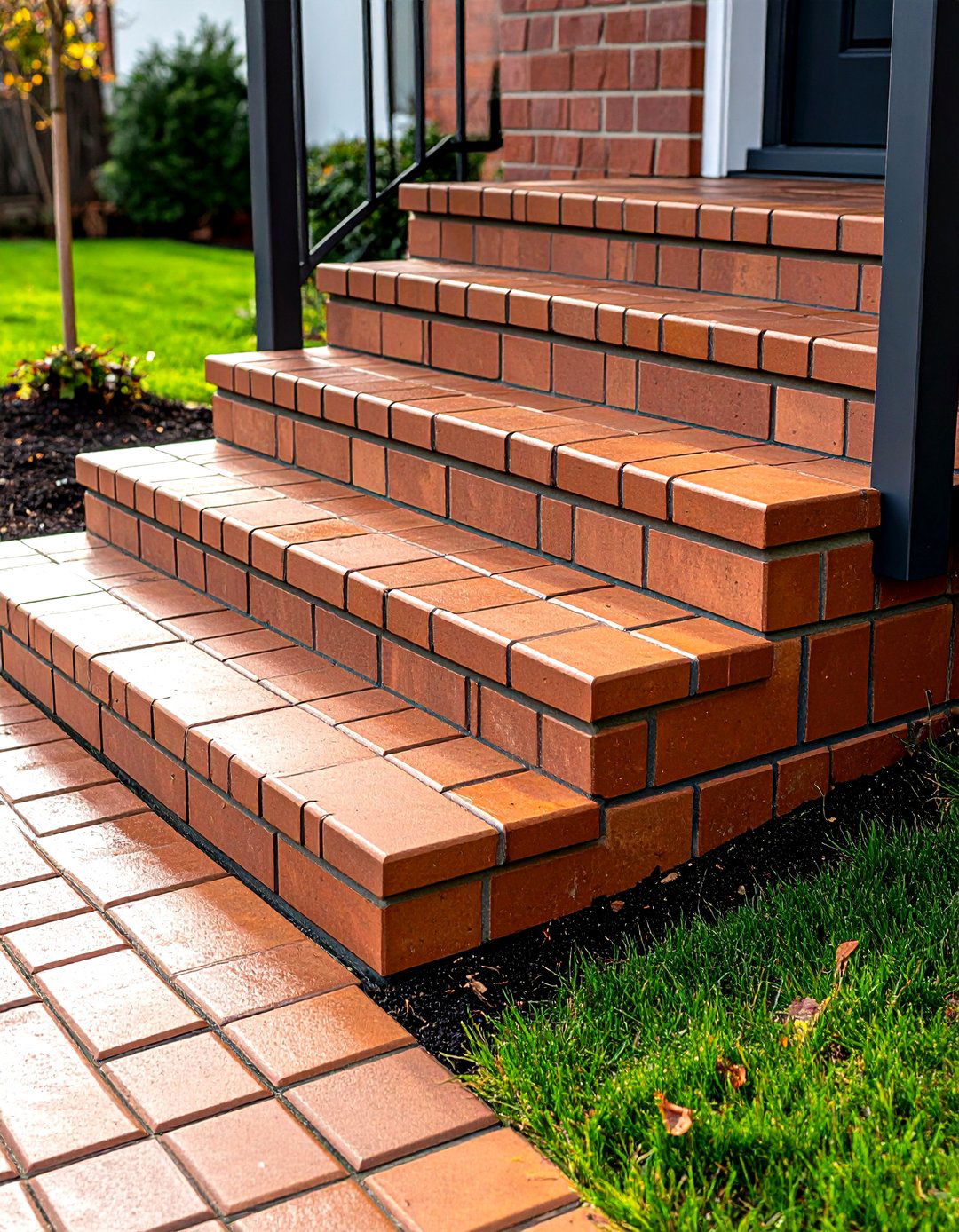
Leave a Reply